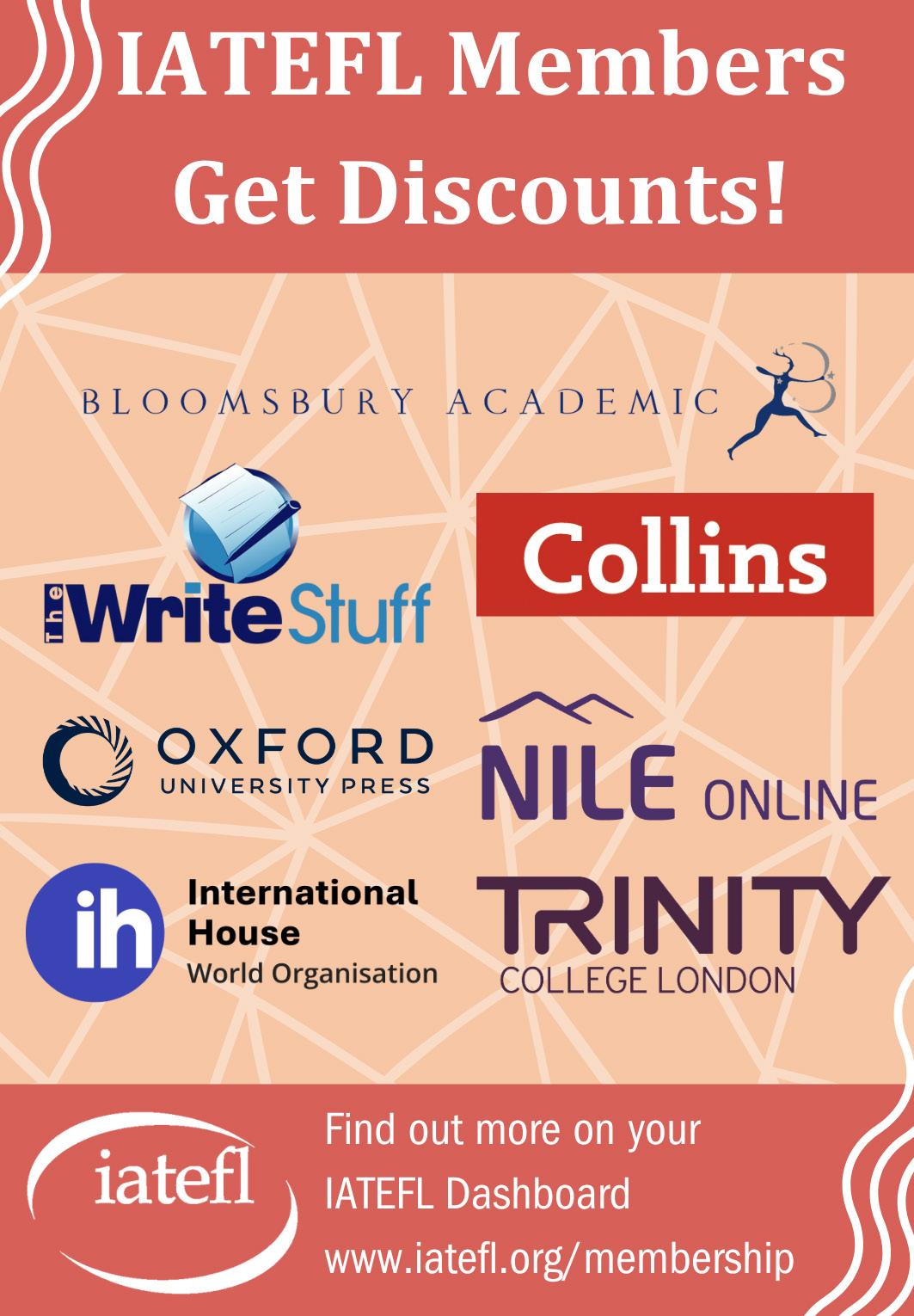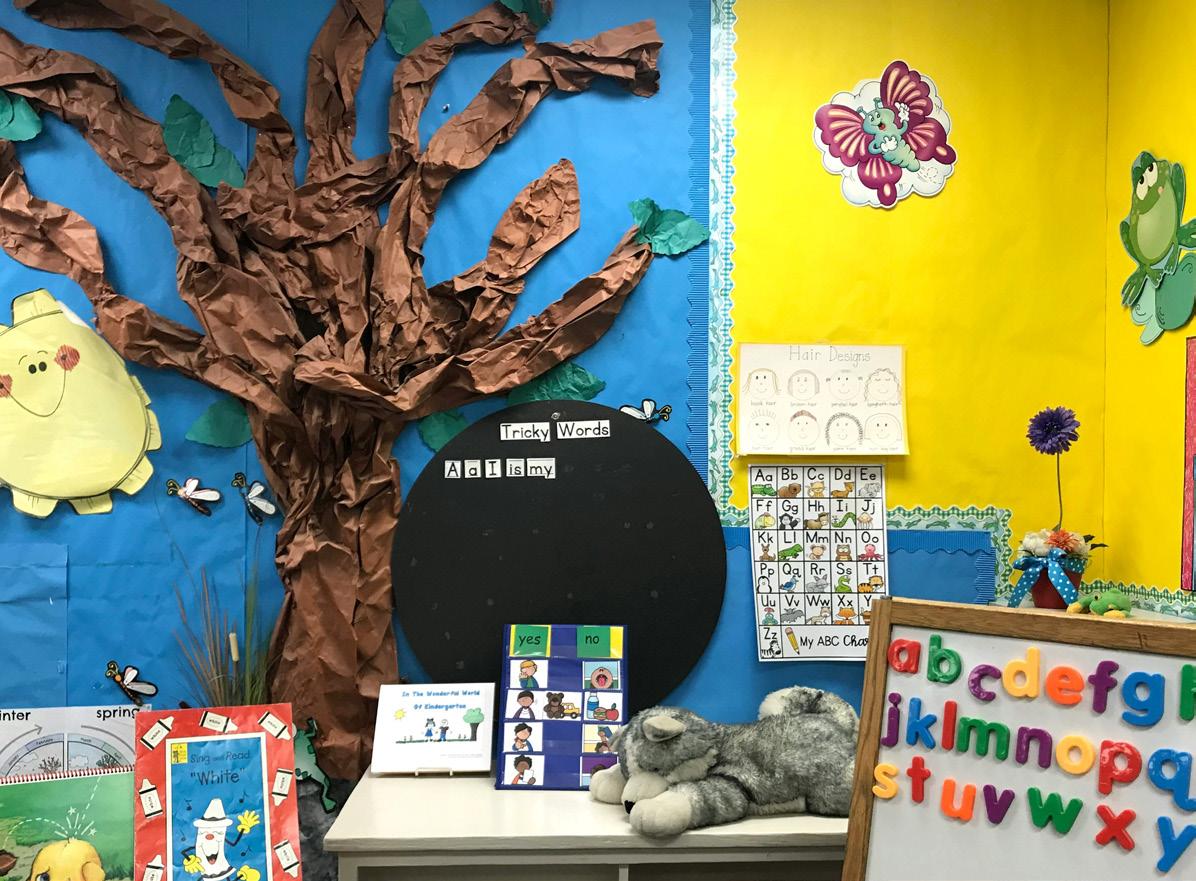

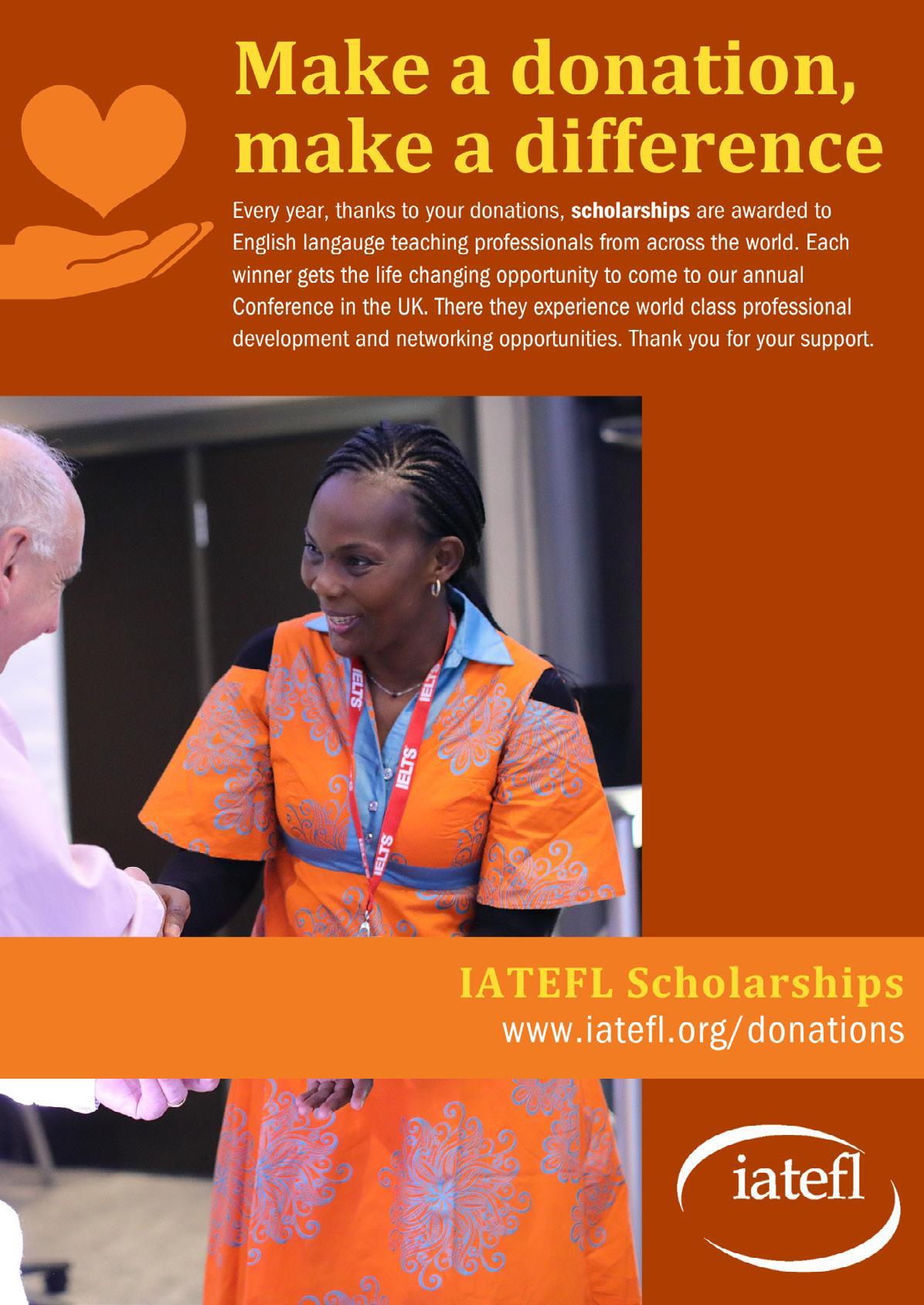




A warm welcome to the November/December issue of IATEFL Voices, the last one of the year and the first one to be completely digital. Following on from our milestone sustainability issue in September/ October, as part of IATEFL’s commitment to more sustainable business practices, IATEFL Voices will be completely digital for both individual and institutional members from now on. This is an excellent opportunity for Voices, and one which sees the introduction of two new columns: Green IATEFL and From the British Council.

Christopher Graham reflects on his first few months as IATEFL Vice President in the From the Trustees column, recounting the challenges and steep learning curve of a new VP but also giving thought to the coming months. Chris has also written the first Green IATEFL article, following on from its introduction in the last issue of Voices. Here, he continues the theme of sustainability, asking various IATEFL members and Trustees what sustainability means for them.
We then move on to the second of our new columns, From the British Council, which for this issue has been provided by Alison Devine, the British Council’s Head of English Connects. Alison summarises some of the professional development opportunities available for teachers and teacher educators and is well worth exploring.
In the first of our feature articles, Peter Westerhuis and Sena Elibal-İçuz explore the use of artificial intelligence in academic writing, considering how AI can best be deployed to appropriately support teachers and students of academic English.
In two related features, Roslyn Young and Laurence Howells present and discuss the Silent Way tradition. Roslyn provides an overview of her work in helping people learn and teach languages. Laurence presents an interview he conducted recently with Roslyn where they discuss a class conversation, what it is and how it can be successfully implemented in the classroom.
Laura Hadwin looks at informal feedback in her feature article, considering how such feedback can be effectively designed and implemented to provide a positive teaching and learning experience.
Vanessa Rodrigues Bocchi Barbosa picks up on classroom positivity through her discussion of classroom management, providing various examples that promote Positive Discipline. Romina Sabia returns to Voices to look at artificial intelligence, her journey using AI tools as well as how AI can promote personalised learning.
Both Seda Yaman and Ahisha Haneef explore learner empowerment, Ahisha through the use of a project-based approach and Seda through considering strategies that can help build learner confidence. Empowerment is the theme discussed by several SIGs in the From the SIGs section, with BESIG, LTSIG and ESOLSIG outlining what empowerment means to them and how they engender it throughout their SIG events and activities.
There are two lesson plans for you to sink your teeth into in the For the Classroom section. In the first one, Mohamed Ramadan provides a lesson about productivity and in the second, Ignacio González presents one on natural disasters in the context of global warming.
Finally, Associates Representative Jean Theuma outlines strategies that teacher associations can adopt to effectively and efficiently promote their events.
With the Annual Conference only around four months away now, November sees the announcement of all the speaker proposals. If you have submitted a proposal, very best of luck. And I hope you all have a lovely and relaxing time over the coming holiday season. See you in the New Year!
With best wishes
Derek Philip-Xu Editor, IATEFL Voices
At the IATEFL Conference in April, Christopher Graham was elected as the Association’s Vice President. Here, he talks about his first few months as VP as well as what is in store over the coming months of his tenure.

I’m writing this in the middle of August in sweltering heat in France. Very different weather from the great British rain in Brighton almost exactly four months ago to the day, when I became Vice President. This is to reflect a little bit on what has happened in the last four months and also to describe some of the things that I hope will happen over my tenure as Vice President, and from the Edinburgh Conference next year, President. These last four months have been a very steep learning curve for me. IATEFL is a complex organisation and there are lots of things that go on behind the scenes that regular members don’t know about – they don’t need to, but I do. I’m grateful for the immense patience from colleagues in Head Office, other Trustees and Committee Members in helping me navigate it, all in my fumbling way.
But what have I discovered? I’ve discovered that you can get things done. Assuming that thing is not a completely ridiculous idea, there is a great deal of support for new initiatives from Head Office, other volunteers and from members. In my case, this has been around the creation of Green IATEFL. Those of you who know me are aware that I’ve been working on the intersection between ELT and environmental sustainability for about four years or so now, and I’m delighted that working with colleagues at IATEFL we are shaping what I think will be a really interesting approach to this. IATEFL has for a while now been working on its own green policies, and Green IATEFL will work to develop and nurture sustainability across the ELT community, with all stakeholders whether they be members or non-members. IATEFL Voices 300 was the sustainability issue, and you will have heard plenty in there about green issues.
But believe me, there’s a lot more to come and you’ll be hearing from me, both directly and through the SIGs and Associates, encouraging you to get involved.
In my day job, I work with teachers in challenging contexts, in conflict and post-conflict settings, and have immense admiration for the way people manage to work in such traumatic circumstances. I hope in my time at IATEFL, we are able to increase our offering for teachers, not just in conflict zones, but also in areas of very low resources and other challenging circumstances. We do of course already work in these contexts in various ways, but I hope we can always keep these teaching settings in our minds as we plan events. To keep me grounded, I have a recollection of a very committed young Iraqi teacher with tears in his eyes talking about his challenges. If you grab me at conference, I’ll tell you his story.
I’m a very committed non-geek, but even I am aware that artificial intelligence (AI) is providing us with great opportunities to do some really exciting things within and beyond our classrooms. But my green antennae have started to ping. Hearing Vicky Saumell’s talk at Brighton in the summer has made them ping even more. So, I’m delighted that IATEFL is engaging with AI, and that we are all talking about it. It’s right that we should, but I hope we
manage to view it through the lenses of sustainability, academic rigour and intellectual property rights as well as its benefits.
Becoming VP was a thrilling moment for me. But it’s becoming a Trustee that has really made me focus. The clue is in the name – trust. Being part of maintaining the integrity of the Association is something that, in common with the other Trustees, I take very seriously. I think I said in my election campaign that it’s important for us to remember that IATEFL doesn’t have any money. It’s your money, and it’s money from sponsors, exhibitors and donors. It’s my money too, thinking about it. Joint responsibility for that money is something I feel very privileged to have been granted.
My final thought is that in my campaign to become VP, one of my undertakings was that if I won, I would be accessible. And that is something I remain committed to. So please never hesitate to get in touch with me. No question is too trivial. And if I don’t know the answer, I’ll let you know, and I’ll ask someone who will know. Equally, if it’s not something that we can do, I won’t hesitate to tell you and explain why. IATEFL is governed by UK charity law, and we have to follow this to the letter.
chris@iatefl.org

Copyright Notice
The International Association of Teachers of English as a Foreign Language was founded in 1967.
Registered as a Charity: 1090853 Registered as a Company in England: 2531041
Disclaimer
Views expressed in the articles in Voices are not necessarily those of the Editor, of IATEFL or its staff or trustees.
Copyright for whole issue IATEFL 2024. IATEFL retains the right to reproduce part or all of this publication in other publications, including retail and online editions as well as on our websites.
Contributions to this publication remain the intellectual property of the authors. Any requests to reproduce a particular article should be sent to the relevant contributor and not IATEFL.
Articles which have first appeared in IATEFL publications must acknowledge the IATEFL publication as the original source of the article if reprinted elsewhere.
all talk
but what is it exactly?
Following on from his articles in IATEFL Voices 300, the sustainability issue, Christopher Graham returns to the recently launched Green IATEFL initiative. In what will be a regular feature for Voices, he navigates the question of what sustainability actually is.

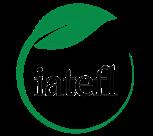
As part of the Green IATEFL initiative, the purpose of this article is to consider the tricky question of what sustainability is and might mean for us.
I’m an ELT person and it’s difficult for me to write something without some kind of activity in it. Sorry. There are three questions below for you to answer before you read any further. You could do this alone, or with colleagues.
I asked the same questions of a number of people within IATEFL including Head Office staff, Trustees, Brighton plenary speakers and from the IATEFL Live team. Hopefully, this will get us all thinking.
1 How would you define sustainability in general and in ELT?
2 What can IATEFL and the wider ELT community do to play its role in fighting the climate crisis?
3 What are the main barriers we face in this?
Here are extracts from the answers from our colleagues, and a few comments from me.
How would you define sustainability in general and in ELT?
Jon Burton (Chief Executive, IATEFL)
It depends on if you are referring to sustainability in terms of the environment, or in terms of things like its ongoing viability and the threat to it from technology – particularly artificial intelligence (AI).
This is interesting because Jon tackles the issue head-on by separating environmental sustainability and the
broader viability of ELT. The two, of course, are interconnected because as we find ourselves increasingly having to meet environmental challenges head-on, this may impact the viability of some of the things that we do in ELT at present.
Andy Hockley (Trustee, Special Interest Group Representative)
Sustainability to me is making sure that you think about how something will be maintained and continued over time. In ELT, to give an example, creating a selfaccess centre for students at your school is only likely to be a successful project if you have thought through the costs and staffing that you will need in order to maintain it and keep it open. In the sense of sustainability as it refers to climate change, there are two strands in ELT: a the business of schools committing to act in an as environmentally responsible way that they can, for example in a carbon neutral way; and b the use of the ‘theme’ of global warming and all that this encompasses, in the lessons themselves.
So, Andy offers an excellent example of a sustainable project for an institution, and he also goes on to make that key distinction between the negative environmental impact of what we do as a community and the role we have in climate change education.
Vicky Saumell (Conference plenary speaker)
For example, using materials for longer cycles, switching to digital whenever possible.
Definitely something everyone involved in materials production needs to think about, and something that would impact the business models of some stakeholders.
What can IATEFL and the wider ELT community do to play its role in fighting the climate crisis?
Sarah Ward (IATEFL Head Office Sustainability Champion)
It is important for the climate crisis to be on the agenda, encouraging discussions and awareness where possible. And it should be done in a way that allows individuals to feel empowered to make small changes to their own practices, doing what they can with what they have in their own contexts.
The importance of context – one size does not fit all. Sarah continues:
The biggest areas of concern are the Annual Conference, and the face-to-face events organised by the SIGs. Both of
these come with a lot of inevitable air travel. We encourage delegates to use other public transport where possible, to make the most of their time in the UK to avoid multiple flights per year. We have also almost eliminated other air travel for face-to-face meetings, encouraging more committees to either meet online or during the Conference, when they would be travelling anyway.
The importance of recognising our biggest negative impacts and engaging with them, rather than hiding them ‘under the carpet’. IATEFL is aiming to become a force for good in this area.
Jon Burton
Jon suggests we can:
Share best practice with other teacher associations and event organisers, and learn from other bodies. Promote best practice amongst other relevant stakeholders: teachers, institutions, publishers, online service providers, etc.
Maria Araxi Sachpazian (Trustee, IATEFL Secretary)
Train teachers to do things differently. It’s easy to tell people to go paperless but this seems scary. We need to provide training and make sure that these solutions are applicable in all teaching environments. Institutions and other employers have a responsibility to build sustainability into their CPD programmes.
Gerhard Erasmus (Trustee, Membership Committee Chair)
We have to move beyond lesson plans and catchy ideas. We need to start asking questions like: Are we actually environmental sustainability compliant in terms not only of paper use, but recycling, renewable energy and within our communities? Are our suppliers compliant? Again, the institutional responsibility aspect.
What are the main barriers we face in this?
Sarah Ward
For IATEFL Head Office, one of the major barriers we face is financial. Often the least sustainable option is the most cost-effective one and we have to strike a careful balance between the two.
This is one of the most complex aspects of becoming sustainable. In the short term it can cost more money.
Jon Burton
Jon reinforces this and adds the angle of eco-anxiety:
Fear and a sense of hopelessness. Not all sustainability actions are financially viable.
Gerhard Erasmus
It will take something drastic, and people are unwilling to make drastic changes until it is too late, says the doomsday prophet. Depressingly, I have to agree with him. But we must keep on pushing.
Jean Theuma (Trustee, Associate Representative)
IATEFL values equality, fairness and has made it clear that it has a neutral stance of issues of a political nature; yet many areas of sustainability overlap into politics. Due to the economic, environmental and social dimensions of sustainability, it may be difficult to separate sustainability from political, religious and cultural approaches. This is a reminder that sustainability is politically charged and has economic
impacts, and that this has consequences for teachers, publishers, authors and other stakeholders. Difficult conversations have happened and will continue to do so.
Anca de Vries (IATEFL Live!)
To actually empower teachers to make changes, we need inspirational leaders to make people look past traditional rules and regulations and to change the way things are done.
And that, dear reader, is a role some of you need to take on in your institution, teacher association or wider community.
Vicky Saumell
And the change of mindset necessary to bring about these changes, in contrast with the ‘how things have always been done’ rhetoric is also an issue.
Alison Devine is the British Council’s Head of English Connects. Here, she summarises some of the professional development opportunities available for teachers and teacher educators

Are you aware of TeachingEnglish – the British Council’s global online community for English teachers and teacher educators with inclusive, up-todate resources and discussion spaces to facilitate collaboration and exchange of ideas? Whether you wish to build your professional network, share tips and knowhow, or learn about the latest research and innovations in teaching, our accessible, open TeachingEnglish platforms provide classroom resources and professional development opportunities, including lesson plans, events, courses and publications.
What’s on TeachingEnglish in November?
Every two months, the content on TeachingEnglish focuses on a different professional practice from the British Council’s framework for professional development. In November, we are
focusing on Knowing the subject. We are also highlighting climate in connection with CoP29.
Our 13 November four-hour webinar event for teachers, ‘Teaching the four skills’, will explore interactive teaching strategies and tools for writing and how to teach speaking skills, with our monthly panel discussing tried and tested ideas for teaching the four skills in the classroom. The event will be available on Zoom and livestreamed into our TeachingEnglish Facebook community
Teachers looking for self-access training can check out our Understanding language systems course, which runs until 30 November 2024. This course helps develop understanding of functional language and grammar and how to apply this knowledge to teaching through reflection, analysis and effective presentation of use and form. Or, if you’re more interested in improving your skills in integrating pronunciation, there’s the How to teach pronunciation course Whatever the course, our Facebook community, Courses for teachers, offers a space to exchange teaching tips, additional resources and reflections on course content.
Teacher educators can learn more about how to support teachers in their professional development by taking our Helping teachers to learn course, which reviews how to plan and deliver effective training, set up and support communities of practice to facilitate collaboration, and learn how to encourage all types of
Conclusion
Hopefully, these questions have given you some food for thought. Back to the original activity, how did your responses differ from those here? Can these questions be a catalyst for further action? Please feel free to get in touch.
‘The most dangerous phrase in the English language is: We’ve always done it this way.’ – Grace Hopper, US Navy Rear Admiral and renowned computer programmer
chris@iatefl.org
self-directed learning. Visit our teacher educator landing page for details of all the resources available and our webinar page for themes, dates and registration for the monthly teacher educator webinar programme.
Through our TeachingEnglish Facebook community, we will also livestream sessions from this year’s ELTons Festival of Innovation on 19 November 2024, where industry experts tackle thought-provoking questions and present genuinely innovative solutions to the real challenges faced by teachers and learners today. While over in our Instagram community, we will be joined by @TeachersofEnglish in Argentina to talk about teacher reactions to this month’s resource shares and what they are saying about Knowing the subject
January?
December and January focus on the professional practice of Taking responsibility for professional development, which helps teachers understand their own professional needs, interests and learning. In our new course, Making time for research in the English language classroom, you can discover how to reflect on and explore issues in your teaching context, plan and carry out a small-scale classroom research project and communicate your findings effectively. Our TeachingEnglish communities on Facebook and Instagram will ask
Issue 290 2022 2022
2019 members to tell us their preferred ways of learning about teaching and what we can all do beyond training. We will shape some of our discussions around our CPD framework, recent webinars on this topic and highlight new publications such as Improving teacher development through the effective use of social media groups, which looks at how we can all use social media to develop our knowledge and skills. Our four-hour webinar event for teachers, ‘Helping our learners develop’, is on 11 December. It will cover integrating social and emotional learning into classroom management, building rapport
and managing stress with teens, and practical classroom ideas that use empathy and emotional intelligence to promote wellbeing.
In response to interest in the topic of artificial intelligence, we have created four new lesson plans for secondary/adult learners on AI literacy: My AI teacher, What is AI?, The risks and benefits of AI and AI and ethics in education. The lessons cover CEFR levels A2–C1. All lesson plans are designed to help learners use AI effectively, safely, critically and ethically –both for learning and for life.
The TeachingEnglish podcast also
focuses on key questions being asked by English teachers all over the world. Each episode features expert guests and explores a current issue in the world of English language teaching; from artificial intelligence to using the creative arts, from critical thinking to how to teach vocabulary and grammar more communicatively. Show notes and transcripts in English and Arabic are available to download for each episode. Series three is out now!
TeachingEnglish@britishcouncil.org
Peter Westerhuis and Sena Elibal-İçuz explore how artificial intelligence can be put to good use for academic writing, helping both teachers and students

Sena Elibal-İçuz is a Senior ELT Coordinator at ETS Global and is based in Istanbul. She has degrees in English Literature and credentials in ELT, with over 7 years’ of teaching experience at the university level, including academic and administrative duties.
Artificial intelligence (AI) is reshaping many areas of our world today, and education stands out as an area where its revolutionary power is particularly evident. With all its diverse capabilities, AI significantly influences how we learn, teach and interact with information. Even while writing this article, the built-in AI in the word processor is suggesting ways of improving our writing, some of which we more than happily accept and apply. As educators, we find ourselves both increasingly fascinated and concerned by the capabilities of AI. Teachers ask, will it be an obstacle to our teaching or impede the students’ learning? The question of academic integrity also worries many people. Is it possible to find a way to harness AI in the classroom before it outwits us?

Peter Westerhuis is a Senior ELT Coordinator at ETS. With over 12 years’ of teaching experience, he has taught English at various levels from primary school to university in Canada, South Korea and France.

Even if definitive answers to these questions have yet to be found, we have the capacity already to harness AI to our advantage. In judiciously leveraging its many capabilities, we can use it to enhance teaching and learning rather than perceiving it as a threat to academic integrity. While informed AI use can potentially benefit various aspects of teaching and learning English, one specific area of interest is its use in academic writing.
Educators face a range of challenges when guiding students through academic English writing. Such challenges include bridging the gap between general and academic English, addressing language barriers and cultural differences. Additionally, they must help students become more familiar with English writing standards. It has been shown that linguistic obstacles and time constraints further complicate the teaching process (Ghafar, 2023). Recently, instructional technologies and AI have emerged as potential gamechangers in the way academic writing is taught and learned. Let’s look at how AI can address these challenges and enhance the process and the quality of academic writing instruction.
The first thing that AI tools, such as ChatGPT, can assist with is creating academic writing curriculum by designing a semester-long programme with weekly themes, learning goals and recommended activities. These tools can also generate model lesson plans for specific classes or even individualised materials for students. Use them to create engaging activities, dialogues and other tasks tailored to the students’ needs. Then use AI tools to generate specialised vocabulary lists, case studies and role-play situations. Generating example reports can also
be a resource to help students understand the teacher’s expectations. Furthermore, the tools can then create assessments to measure student progress and comprehension of the material.
One remarkable aspect of AI support for educators lies in its capacity to tailor an existing curriculum to address the distinct requirements of diverse student groups. By providing guidance on effective pedagogical methods, fostering interactivity and suggesting engagement strategies, AI can help classroom materials remain both captivating and impactful.
When it comes to evaluations, AI can help set up feedback systems for gathering student writing responses. These responses can also be used to help refine curricula. AI streamlines the grading of written assignments and can also identify writing patterns and trends in a classroom. It can assist with teacher administrative tasks, generate rubrics, manage data for class reports, write reports and summarise documents.
To maximise the benefits of AI tools, educators should continuously improve the prompts they use. AI models learn from the data they are exposed to, and by refining and iterating on the prompts, you can achieve more accurate and relevant output. Here are some tips from ETS AI Labs for guidance in this process: Be laser-focused Craft clear and specific prompts to ensure that the AI tool understands the desired output. For instance, instead of asking it to ‘Write an essay on the environment’, ask it to ‘Write a 500-word explanatory essay on the effects of climate change on marine biodiversity, highlighting three specific species and their changing habitats, with three main points and a conclusion’. This way you receive a structured essay that you can review and adapt to use as an example with your students.
Question it right
Formulate relevant and engaging questions to elicit creative and informative answers. Rather than asking, ‘Can you help me with grammar lesson planning?’, specify your needs by asking, ‘What strategies can first-year university students use to improve their grammar skills in academic writing?’ This approach ensures that the AI tool provides more targeted and useful responses.
Optimise with context
Provide background information to help AI tools generate more accurate responses. Specify the essay’s purpose, audience and scope, and include any relevant research or sources that have already
been consulted. This additional context ensures that the AI tool can tailor its output to meet your specific needs. Engage, don’t dictate Use AI tools as collaborative partners to generate new ideas and insights, rather than simply issuing commands. Start your writing prompts with openended questions such as ‘What are some common mistakes in academic writing at the university level, and how can students avoid them?’ Then, refine your needs with follow-up questions (ETS, 2023). This method ensures a more interactive and productive dialogue with the AI tool, leading to richer and more nuanced responses.
With the abundance of online resources available to help teachers use AI tools responsibly in the classroom, it can be overwhelming to know where to begin. AI 101 for Teachers stands out as a particularly valuable resource, offering online learning sessions with experts, along with practical guides and companion resources. One particularly insightful session explores how AI can be integrated with pedagogy to enhance student learning. The series also covers topics ranging from demystifying AI to promoting a responsible approach to its use in education. It also provides insights into teaching with AI tools and leveraging AI for assessment Practically speaking, educators may also start by using the pre-made prompts they provide and then adapt them to their needs. By following these guidelines and examples, teachers can improve their teaching of academic writing, benefiting both themselves and their students (Code, 2023).
If you would like to learn more about different AI tools and how to incorporate them into your preparation and teaching, you can watch the recording of the Virtual Seminar for English Language Teachers: Humanizing AI for Learning and Assessment. Participants share ideas, present different AI tools and discuss best practices for maintaining a human touch while incorporating AI into the classroom. If you specifically want to explore using AI for academic writing purposes, register for the ETS teacher webinar series which includes a session about using AI tools in academic writing, with examples from the TOEFL iBT test.
Potential plagiarism and disruption of learning due to excessive dependence on AI tools are getting teachers and institutions concerned about AI use for learning purposes. Imposing a ban on AI use, however, might not be the ideal solution since developing AI literacy and competencies will most likely be important skills in the future.
A more balanced and guided approach to AI use can be instrumental in addressing concerns associated with overreliance and misuse issues. Instead of an outright ban, teachers and institutions can provide guidance on the responsible and ethical use of AI tools and raise awareness of its limitations and potential dangers. As a first step, certain restrictions and guidelines on how to use AI and for what purposes can be included in the syllabus or code of conduct (Fengchun & Holmes, 2023).
To ensure AI use does not disrupt learning or undermine human agency, AI-assisted activities can first be modelled in the classroom and combined with critical thinking. Here are some ideas for involving AI in your academic writing classes to encourage your students to use it appropriately.
Ask your students to come up with ideas about a writing topic and then prompt AI to do the same. You can then ask your students to compare and contrast their own ideas with the AI-generated ones. They can improve their original ideas with the AI output, or you can encourage them to think critically about the AI-generated ideas. Since AI has its own limitations generating output, it can be scrutinised critically and improved.
Summary
Students can use AI for reading into writing activities, such as summary writing or summary and response writing. They can compare their own summaries with the AI-generated ones and check their own summaries for redundancy, missing information or possible improvements.
Checking register
Your students can get AI to check their writing for appropriate tone and delivery and get feedback to improve. They can practise delivering the same information to different audiences or in different styles, using targeted vocabulary.
Test preparation involving academic writing
AI can also help with test preparation by providing sample task prompts based on examples it is fed with. By providing AI with scoring guides, you can also get feedback on written responses. A good example can be the TOEFL iBT test, which is a major English proficiency test that includes the assessment of academic writing along with
Issue 290 2022
2019other language skills. The Integrated writing task in the TOEFL iBT test requires reading a short passage and listening to a short lecture on the same topic, and then summarising the points mentioned in the two sources and explaining how they relate to one another. As a suitable AI tool that can provide feedback on written input, students can feed ChatGPT with the reading passage and the lecture script along with the scoring guide for this task, which is publicly available, and get it to score their written responses. ChatGPT can also be prompted to give feedback on task completion, coherence, organisation and language use in student work. After a teacher-led demonstration in class, students can use such AI tools for selfstudy, a practice that will also encourage learner autonomy in test preparation. Linguistic improvements Why not ask your student to write something, and then get AI to polish its linguistic features? They can then compare the improvements to their original work. Students can get AI to give feedback on various aspects of writing, such as grammar, syntax, lexis, organisation, coherence, cohesion, redundancy and mechanics.
Overall, when incorporating AI in learning, make sure AI use supports educational goals you intend to meet by focusing on improvement, developing
learner autonomy and using human agency to make the final decision (ETS Research Institute, 2024).
Ethical considerations
Beyond such concerns as plagiarism and disruption to learning are much deeper ethical issues that need to be considered regarding AI use for teaching and learning purposes. One issue is the hidden bias and discrimination in AI output. Since generative AI training data is the Internet itself, which contains a great deal of biased information and discriminatory language, AI has the potential to generate content that may be deemed unethical and offensive. What is interesting is that such bias and discrimination mostly occurs toward already discriminated-against groups since minorities, marginalised communities or the Global South have limited presence and representation online. Since AI mirrors dominant worldviews, teachers should encourage students to be critical of AI output (Fengchun & Holmes, 2023).
With such technology having the potential to deeply impact education and integrity, it is critical to take the first steps into ‘taming’ it to make sure the impact does not go beyond what is controllable. AI technology is here to stay, and it will only get better, keener and stronger in time. We need to make informed decisions now about how we use AI because the
improvements in AI technology are heralding big changes in all aspects of life. With all its potential risks that make us refrain from ever including it in our teaching, let us also keep in mind that it has a lot to offer to facilitate learning and teaching processes.
Code. (2023). AI 101 for Teachers. Code code.org/ai/pl/101
ETS. (2023). ETS R&D. ETS www.ets.org/ research/ai-labs.html
ETS Research Institute. (2024). Responsible use of AI in assessment. wwwvantage-stg-publish.ets.org/Rebrand/pdf/ ETS_Convening_executive_summary_for_ the_AI_Guidelines.pdf
Fengchun, M., & Holmes, W. (2023). Guidance for generative AI in education and research. UNESCO. www.unesco.org/ en/digital-education/artificial-intelligence unesdoc.unesco.org/ark:/48223/ pf0000386693
Ghafar, Z. (2023). Teaching writing to students of English as a foreign language: The Challenges Faced by Teachers. Journal of Digital Learning and Distance Education, 2(2), 483–490. doi.org/10.56778/jdlde. v2i2.123
pwesterhuis@etsglobal.org selibal@etsglobal.org
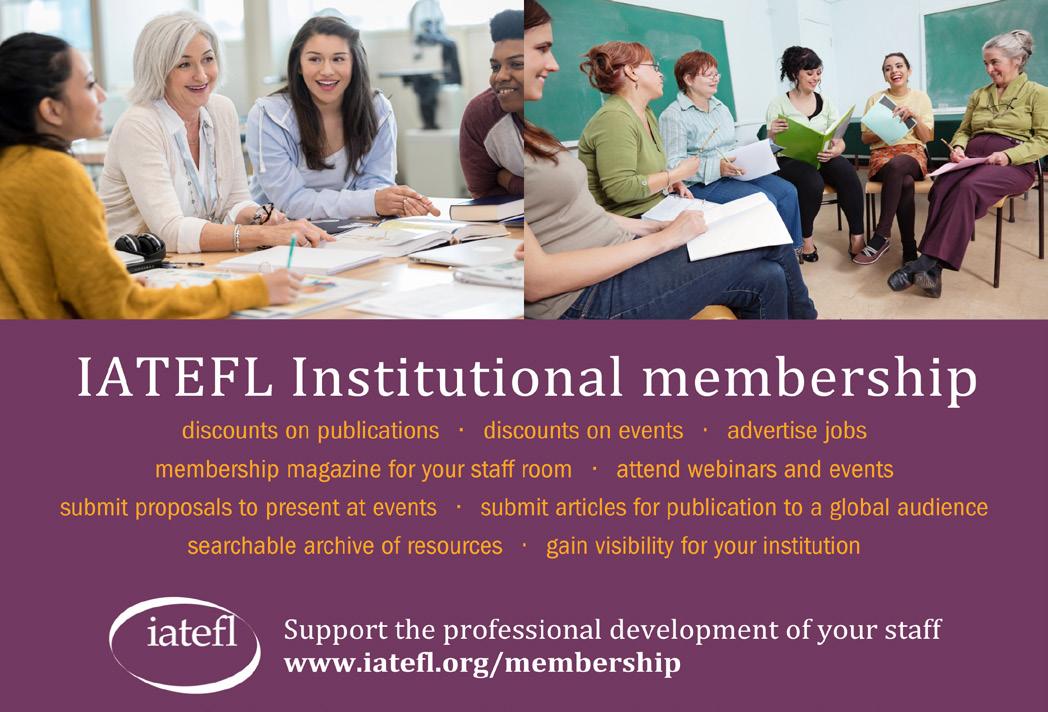
In this article, Roslyn Young presents the work she has done in the Silent Way tradition, an exploration of learning to speak and speaking to learn
In this article, inspired by my work in the Silent Way tradition, I present a different way of thinking about how people learn and teach languages, captured in the twin aspects of the title, ‘learning to speak, speaking to learn’.
Knowledge vs know-how
Let’s begin with a story, a true story which takes place at various times, in many cultures and in different disciplines.
One day, a youth became apprenticed to a master craftsman, a carpenter. He spent some days in the workshop doing menial tasks, observing all that took place. Soon he was given more important tasks. His master used a coaching process; showing him the gestures he had to learn, watching how he worked, and commenting, showing him good practice. Hold your plane like this. It has to be completely flat and level; otherwise, you’ll bite into the wood. Careful of the pressure … Press a little harder with this hand ... That’s better.
Our apprentice’s principal way of knowing was through hundreds of experiences gradually accumulating to become his experience: which gestures are required for each tool, how to adapt them to the various woods, etc.
He became skilled in his craft and proved this by creating his masterpiece; he had become a master craftsman. He began to take apprentices himself and the process started over again. It has been repeated down through the ages, in some countries, to this day.
One day, an idea came to the master craftsman. He would write a book about his craft. To do this, he had to describe many things which, when in the workshop, were evident. He had to describe the tools and the gestures each tool required, the woods he used for different jobs, and so on. The master craftsman converted his knowhows into knowledge. The book was duly published and placed in libraries, the role of which is to hold a culture’s knowledge, and thus made accessible to all.
Many years later, I become interested in woodworking. I find several books on the subject, all descendants of the first

Before retiring, Roslyn Young taught English and sometimes French for many years at the Applied Linguistics Centre of the University of Franche-Comté in Besançon, using the Silent Way and techniques derived from it. You can see her using the Class Conversation technique for Dogme-like guided, free conversation on YouTube.
book written in my culture by a master craftsman. Reading these books and, more recently, watching YouTube videos, give me the same thing: knowledge. Knowledge gives me an entry point into the challenge, but it doesn’t give me what is essential in learning new skills: experience.
I need to get a feel for my tools, the angles to hold them at, the varying pressures they require me to exert. I need to become familiar with various woods, glues, oils … In other words, I, too, need to accumulate hundreds of experiences that will coalesce into my experience and become my know-how. How does one learn know-how? There is only one way, and that is to do it, whatever ‘it’ might be. One accumulates experiences using trials and the feedback they yield to build experience. This is true of skating, of baking cakes or of playing the guitar.
This has always been known: we teach know-how by giving learners opportunities to do ‘it’ and by giving them feedback. Speaking is an activity; it’s something we do. Learners need to keep their wits about them to develop a linguistic agility in the new language. They need to develop a physical agility, the motor skills to use their mouths differently. For the time it takes you to read this article, I would ask you to entertain the idea that, for teaching purposes, speaking a foreign language is best seen as know-how. The takeaway Knowledge does not spontaneously change into know-hows. The only way to learn a know-how is to do it until you know how.
In 2018, an overview of the scientific understanding of learning wrote:
‘Quite literally, it is neurobiologically impossible to think deeply about or remember information about which one has had no emotion because the healthy brain does not waste energy processing information that does not matter to the individual.’ (National Academies of Sciences, 2018, p. 29)
Textbooks try to be relevant and engaging, but nothing in a textbook, no role play, no exercise, will ever have the emotional charge of even the simplest sentence said by someone because this is what they want to say.
In both cases, words come out of a student’s mouth, but only in the second case is language being used as we use L1, with genuine self-involvement. This is real speech. Without self-involvement, we might call what is being produced ‘sp.ch’ (speech with its heart missing). Sp.ch is only a pretence of speech.
When talking about schoolchildren, Holt (1983) wrote:
‘It can’t be said too often: we get better at using words, whether hearing, speaking, reading, or writing, under one condition and only one – when we use those words to say something we want to say, to people we want to say it to, for purposes that are our own’ (p. 124). This is just as true for L2 students. The takeaway Learners’ emotions must be engaged. This will always be the case if they speak about what they choose to, but rarely the case if the teacher makes the choice.
Ferdinand de Saussure is considered to be the father of modern linguistics. He defined the boundaries of the discipline by proposing two entities: a formal system of elements such as syntax, semantics, morphology, etc. which he called langue, usually translated as language; and a second entity, used by humans in the messy business of talking, which he called parole, usually translated as speech (Saussure, 1983). The discipline of linguistics is concerned with Saussure’s langue and formally excludes speech
The problem is that we teachers have been trained in grammar, syntax, phonetics, all part of Saussure’s langue. But our students have come to class wanting to learn parole, the know-how
Issue 290 2022
2022 2019 to speak the language. They are given examples, rules and grammar points and then practise these with exercises where they use (emotionless) sp.ch. It is expected that this will turn into a capacity to produce parole, natural spontaneous speech. The fact that so many students are tongue-tied in real life when they have to speak shows us that working this way is unsatisfactory. This should not surprise us. In no other field are know-hows taught from the rules backwards, or from pretences rather than the real thing. We don’t tell children to pretend to play football before giving them a ball and letting them play. Why demand that students pretend to speak?
As Wittgenstein (1953) pointed out, children learn games by playing them. The rules are made explicit, if ever, only when this is necessary. What happens is that every time a rule is broken, new players see the consequences, and this is enough for them to pick the game up.
The same approach in language teaching is to view L2 as know-how and to use parole – real speech – directly; no rules, no explanations, no teacher talk, just students using the language in sentences generated by themselves. The teacher acts as both referee and coach; referee when telling students that their sentence is outside the boundaries of the language, and coach when helping them to formulate correctly what they want to say. The teacher does this by giving feedback after every sentence, helping the student to get to a final correct form before the next one is said.
The takeaway To learn to speak, learners need to speak and to receive feedback.
Imagine that you are an ice skater learning to perform an axel. You jump ten times and then your coach tells you, ‘Your third try was the best; your left hip was high and you jumped outside your circle. Well done.’ This commentary is much too late to serve any purpose. To be useful, feedback must be given immediately after each trial.
In a language classroom, one of the main jobs of the ‘teacher as coach’ is to provide useful feedback. Each sentence should get feedback as soon as it is finished. This does not mean simply reformulating the student’s version. Nor does it mean correcting what students can rectify for themselves. It does mean the more subtle process of developing their criteria so that they understand what misconception(s) created any problems. It also means introducing new language where this is needed for students to properly express the idea they have in mind. Lessons like these are the

Wednesday evening ‘training session’ with the coach, as opposed to the ‘playing the game’ session on a Sunday afternoon when people simply talk to each other. Giving precise feedback economically requires tools. The tool we use most is finger correction; one word for each finger. This is intuitive and easy. Fingers can be waggled, grouped, folded and crossed. Fingers are used to guide learners as they reflect on what they say. It is so useful that many students start using their fingers to reflect on their productions.
The takeaway
Timely feedback is essential in the learning process.
Languages give their speakers different ways of talking about the world: Japanese speakers don’t talk about the world as French speakers do or as English speakers do. Japanese manages with no articles, no plurals, no gender, and rarely uses pronouns; how is that possible? French speakers use many pronouns; not only that, they cram them all into the beginning of their sentences. How do they manage? English speakers can ‘put down’, ‘put up with’, ‘put one over’, and so on. How strange! We call these fundamentally different modes of expression ‘the spirit of the language’, those things that make each language uniquely foreign.
Discovering the spirit of a language directly, from the beginning, generates astonishment and a desire to find out more. As one learner put it, ‘I love
learning Japanese. It’s SO foreign!’ The excitement appears where the foreignness is most apparent, with the use of the functional vocabulary. The lexical vocabulary comes easily when introduced later, once this core has been explored.
The takeaway
Learning is exciting and inviting when students meet the language at its most foreign. We exploit this.
Just as the master craftsman guides his apprentice by giving him experiences that build into experience and become know-hows, so teachers working in the Silent Way tradition guide their learners sentence by sentence until they reach a know-how-to-speak-the-language. In doing this, we teach students what they came to class to learn.
Holt, J. (1983). How children learn Pelican.
National Academies of Sciences, Engineering, and Medicine. (2018). How People Learn II: Learners, Contexts, and Cultures. The National Academies Press. doi.org/10.17226/24783
Saussure, F. (1983). Course in General Linguistics. Duckworth. (Original work published 1916) Wittgenstein, L. (1953). Philosophical Investigations. Blackwell.
roslyn.young@orange.fr
Following on from Roslyn Young’s article on the Silent Way teaching methodology, Laurence Howells presents an interview he conducted with her about her work

Since retiring as Chief Executive of the Scottish Further and Higher Education Council in 2016, Laurence Howells has focused on teaching and learning languages, producing over 150 educational films for silentway. online. He is currently learning Japanese, French and Spanish. Introduction
This article is based on an interview with Roslyn Young in January 2024. Roslyn Young is an expert on teaching languages. She has 60 years’ experience teaching English and French and she has written extensively on learning and teaching and their application in the foreign language classroom.
A Class Conversation is just an ordinary conversation, except that the students are speaking in the language they are learning. So the students provide the content of the lesson – whatever they want to talk about from their lives, interests and concerns –and the teacher helps them to express it in good quality English.
A student launches a sentence – it could be a question or something they want to tell people about – and the teacher works with this student and the rest of the class to turn this attempt into correct, wellpronounced English.
It is this process, undertaken sentence-by-sentence that makes it a lesson. Without this, it would be just a conversation in poor English: students can do that by themselves outside of class. Class Conversations are not for beginners. Students need a solid base in pronunciation and the ability to use the functional vocabulary at intermediate level.
How does the teacher build the course around the students’ needs?
Students of English invariably have problems with pronunciation and almost always with the English system of verb tenses. As a result, these become the focus of the course. And because the functional vocabulary comes into every sentence, students also work on this. Sometimes, they will need new vocabulary. Therefore, the teacher needs the skills and tools to work with students on these things.
If students are to learn, every sentence must be worked on until it is correct. As far as possible, the teacher should guide the student, together with the rest of the class, to do much of the correction themselves. The teacher helps by first showing only where the problem lies, and then by offering hints if necessary. When the sentence requires linguistic knowledge the students don’t have yet, the teacher provides what’s needed.
The process of working on sentences is done as a whole class activity because everyone learns from observing the process unfold. And if the whole class is kept together, attentive and involved, everyone gets full benefit from the lesson.
How many students can you have in a successful
It’s preferable to have at least ten students because that makes for variety in the conversations, but Class Conversations can be run with any class of more than one student. If the teacher has more
experience, then classes of 20–30 students can easily be run. The largest group Roslyn Young ever taught was a group of 55 students on a week-long summer course for English in August 2010.
started?
Students new to this way of working need help to get started. So the teacher seeds the first few Class Conversations with questions like: ‘What did you do last weekend?’ or ‘Where are you from?’ These are simple, open-ended questions that members of the class can ask each other and that everyone can answer. Each answer will be different and personal, and they can be answered at many levels of detail. As they gain confidence, students learn to follow up if an answer intrigues them. They also learn to come to class with something to tell everyone.
After the first few Class Conversations have been launched, all the teacher has to do is make an encouraging gesture and wait until people have had time to think of their first sentence.
Intermediate students need the skills to express themselves about simple things – their everyday lives and activities –spontaneously and with ease. This is the priority at their stage in learning a language: more complex things will come later. The ease they gain from speaking about their lives and listening closely to their classmates doing the same gives them confidence in speaking English. To
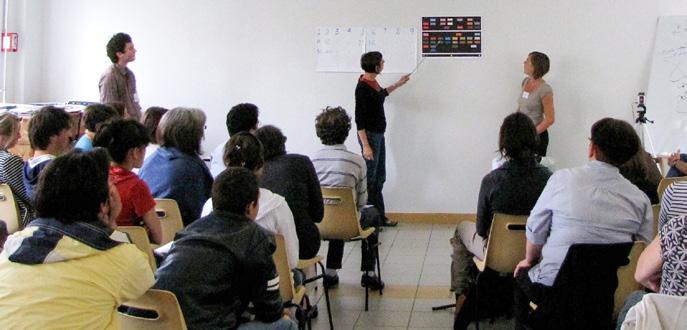

Working on the English verb tense system, August 2010
see this idea in action watch this video
In a sufficiently long series of Class Conversations, the class will encounter all the common structures and most of the common vocabulary they need for everyday conversation. This is normal; the common things occur and recur because they are common!
Nothing is more interesting than humans. And all our students have stories to tell, even if they’re only about their hobbies or holidays on their aunt’s farm or what happened on the way to the dentist yesterday. Stories that seem unimportant … But telling their stories turns them from a group of students into a group of people; people who have lives, histories and dramas. This is what we want as teachers.
We don’t want them saying things they have no emotional engagement in. If they have no personal investment in what they’re saying, their brains simply won’t deal with what’s being worked on and the lesson will leave no lasting impression.
This means talking about themselves, always telling the truth, asking other people about themselves, and expecting to hear something truthful about them and their lives.
‘The content most likely to engage learners and to trigger learning processes is that which is already there, supplied by ‘the people in the room’. (Meddings & Thornbury, 2013)
Conversation invented?
The circumstances around its invention were very particular. Roslyn Young taught a week-long English course in 1978 near Lyons in France. The class was made up of a closely-knit group of about 35 primary school teachers from France and Switzerland who were using Caleb Gattegno’s approach in their teaching
(for more information see: silentway. online/). They had been working together for nearly ten years, one full weekend each month. This was a group of friends, including the teacher herself, and the level of trust was therefore exceptionally high. At one point around mid-week, the students just started taking the class over, talking and joking in English, and Roslyn simply followed them. She worked sentence by sentence with the students to correct what they’d said; the essence of the Class Conversation was created.
From the early 1980s, it was used systematically by a group of eight teachers at the Centre de Linguistique Appliquée at the University of FrancheComté in France. This team developed specific tools and techniques to make it more effective, and it is still in use there.
All classes have people at different levels. How can the teacher deal with this?
Pronunciation is the great leveller. It is advantageous to teach pronunciation as a motor skill (for more information see: www.pronunciationscience.com/); it is much more efficient than any ‘listen and copy’ process. The teacher can then demand a much higher standard of pronunciation from the faster or more advanced students. This means they keep improving. It also means that the weaker students hear better and better pronunciation from their classmates, and learn from observing how it was achieved.
You can get the faster students to make more complex sentences. For example, they can be asked to take the last few sentences and find ways to combine them into one longer one or to find different ways of expressing the same meaning as intended in the current sentence.
You can also send them off into a corner of the room to practise saying their sentences several times. When they come back they may want to say the sentence again so that the teacher can check it or deal with any doubts they have. Even the more advanced students find that complicated sentences can’t be pronounced fluently and accurately without practice. While these students are doing work like this, the teacher can give more time to others in the class.
How do you deal with students who don’t want to say anything? Or those who never stop talking?
Reticent students often just need encouragement and time to get used to the situation. But if after a lesson or so,
despite being given opportunities, they still haven’t spoken, then they can be taken aside and you can say, ‘Do you mind if, for the next lesson, I tell the rest of the class “We don’t know much about X. So today, let’s ask him (or her) and find out as much as we can”’. The student concerned invariably says ‘Yes’ and that is usually all that is needed to get them launched.
Very occasionally this doesn’t work. But then it becomes the student’s problem. We can only continue to give them opportunities and encourage them. People sometimes have to deal with difficult issues in their lives and we have to respect that.
Very loquacious students can be taken aside and made aware that they are using more than their fair share of ‘airtime’. They can also be held in check by limiting their participation to only asking questions or seeking more details. This can have the added advantage of keeping the conversation going.
Taking notes in a Class Conversation isn’t permitted. All the students need to be completely present to what’s going on in class all the time. There are all sorts of subtle things going on as the class works: little gestures, movements of eyebrows, smiles and frowns, tones of voice … and the students need to be aware of these. This goes beyond the details of work on the language: if the class is meeting as people, then they need to be aware of each other as people. Taking notes breaks that awareness and divides their attention in a very damaging way.
In fact, notes are simply not needed. If the work on each sentence is properly practised, then the learning has already been at least partially lodged where it needs to be – in students’ minds, and not on pieces of paper. And then, the process of sleep will naturally consolidate the work in each student’s mind.
Reference
Meddings, L., & Thornbury, S. (2013). Teaching unplugged: Dogme in English language teaching. Delta.
Laura Hadwin examines the use of feedback in the classroom and presents various activities that can be used to provide meaningful feedback to learners
‘Feedback is a free education to excellence. Seek it with sincerity and receive it with grace.’ – Ann Marie Houghtailing
I’ve been incorporating informal feedback activities in my English language classes and improving my teaching as a result. As teachers, we are continually giving feedback to our learners so that they can improve. It is equally important that we elicit feedback from our learners about their learning so that we can further help them improve. The more information we have about their strengths and challenges, the better we can help them. Additionally, we need to know their perceptions of our teaching, the activities and materials. Feedback fatigue is real! I’m rarely surprised nowadays when I get asked for feedback after buying sweets or vitamins! The feedback activities I have designed and selected are short and sweet, and I’ve also tried to incorporate a healthy dose of creativity to make them more engaging!
Feedback activities: design
Feedback activities in teaching and learning are referred to as Classroom Assessment Techniques (CATs) in adult education (andragogy). I have adapted guidelines from Classroom assessment techniques (Angelo & Cross, 1993, p. 26).
1 Is the CAT context-sensitive? Will the assessment provide useful information on what a specific group of students is learning about a clearly defined topic at a given moment in a particular classroom?
2 Is it mutually beneficial? Will it give both teachers and learners the kind of information they need to make changes and corrections to improve teaching and learning?
3 Is it easy to administer? Is the assessment technique relatively simple and quick to prepare and use?

Laura Hadwin is an English language instructor at Camosun College in Victoria BC, Canada. She is interested in teacher beliefs and identity, materials design as well as creativity in teaching and learning. She has taught and delivered teacher training in South Korea, Spain, the UK, Turkey, Qatar and Mexico. In her free time, she enjoys yoga, volunteering and exploring our beautiful world!
4 Is it easy to respond to? Is the feedback that results relatively easy to organise and analyse?
5 Is it educationally valid? Does it reinforce and enhance learning of the specific content or skills being assessed?
I have organised the feedback activities from more to less controlled. They can be modified or adapted to suit specific teaching and learning contexts. Feedback from learners about their progress can also be combined with feedback for the teacher about the teaching, materials and activities. I use post-it notes, recipe cards or cut-up pieces of coloured paper, and I usually get feedback at the end of the week or the end of a unit.
Two-or-Three Sentence Summary
(adapted from Angelo & Cross (1993), p. 183)
Learners can focus on whatever has emerged that week in relation to their learning and/or the teaching. A more general holistic approach can produce revealing insights; however, paradoxically, it can also generate formulaic or unspecific responses. Training learners on providing feedback before moving on to more open feedback is a useful strategy. If there is a particular area the teacher or learners want to address, it can be the feedback focus, for example, speaking or group work. Some educators argue that feedback should be separate from instruction, but I see many opportunities to incorporate and review learning, particularly as I get feedback frequently, making it lower stakes. Learners can be encouraged to write compound, complex or compoundcomplex sentences to practise writing skills. I usually make feedback
anonymous, but it can still be errorcoded and handed back the next day for learners to correct, regardless of whether it was theirs. This workshopping of the language should occur after the teacher has gone over key trends in the feedback and discussed how it will be addressed in subsequent lessons.
(adapted from Angelo & Cross (1993), p. 154)
Muddiest Point requires learners to identify the area they are most confused by. Teachers are often time-pressured and cannot do much individual concept checking; Muddiest Point is popular as it quickly and easily allows the teacher to identify what learners are unsure about. Learner-generated feedback requires learners to take ownership of their learning, thereby promoting autonomy. It also allows them to feel heard, which promotes agency. Additionally, reflection and noticing are key components of independent learning.
This traffic light analogy uses green, orange and red to inform the teacher of what areas learners are confident about, unsure about or feel they need to improve. For teacher feedback, I use ‘Start, Continue, Stop’. Both modes of feedback are very direct and clear. Learners can also complete the feedback on post-it notes or cut-up pieces of green, orange and red paper.
Like a one-to-five star online review, learners assign stars to teaching and learning categories. For learning feedback, this could include the four skills (reading, writing, listening and speaking), vocab, pronunciation and grammar. For teaching feedback, it could include materials (handouts, coursebooks, online resources, cards, etc.), assessment, activities (games, tasks, role plays, projects, etc.), group work (pairs, groups or whole class), classroom dynamic and atmosphere, use of technology, timing and flow, organisation of the week, classes or activities, homework, etc. Learners can address specific categories or choose which ones they feel strongly about from a list.
A variation on Star Ratings is Rankings, where learners rank the top three to five areas for learning and/or teaching
Issue 290 2022
2022 2019 feedback. Evaluation is a higher-order thinking skill, and practising it is useful for transfer to other contexts. As in Star Ratings, eliciting the topics from learners encourages deeper engagement with their learning. Encouraging them to support their responses will yield richer feedback and provide more opportunities for targeted future action. Requiring elaboration strengthens critical reflection and highlights the importance of substantiating our ideas.
Graphic Organisers
Graphic organisers provide flexibility in gathering feedback. They also allow for considerable adaptation and creativity.
❚ Mind Map: A basic mind map shaped like a cloud with lines emerging from the centre can be used, or the teacher can modify the organiser to complement the topic. For example, if the unit is on food, the organiser could be designed to look like a type of food, or if it is on nature, it could resemble an animal. This unifies the content and learners can decorate their organisers as well.
❚ SWOT: This graphic organiser is borrowed from business. SWOT stands for strengths, weaknesses, opportunities and threats. This method combines student perceptions of their ability (strengths and weaknesses) and external factors (opportunities and threats). The opportunities and threats could include the teacher, institution and wider world. It is wonderful for ELT to borrow from other disciplines – many activities in general education training sessions, such as icebreakers, fillers
and revision games have been used in ELT for decades!
❚ T-Chart: Learners list pros and cons or strengths and weaknesses of their skills or the course. It is crucial to be very clear when seeking feedback on teaching (I have used ‘challenges’ and ‘weaknesses’ to get feedback, and learners list their language limitations rather than identifying areas for improvement in teaching).
GLAD(S)
GLAD stands for grateful, learned, achieved and delight. I do a daily GLAD in my diary, and it can be based on teaching, my personal life or a combination of both. There is strong evidence to support a gratitude practice in positively affecting mental health, which is particularly relevant nowadays. I therefore think it is key that learners celebrate their successes and cultivate joy in their learning. Later, I also encourage them to start doing GLAD outside of class to boost their moods. I do my GLAD in Spanish, and I show learners how these small L2 moments add up to greater language acquisition. Teacher modelling of selfcare and language learning strategies demonstrates authenticity and credibility.
The teacher can set up this activity on post-it notes with learners posting their notes on the whiteboard and reading one another’s posts. With this variation, it is key to tell learners that they will be posting their responses for everyone to read. I have also added an ‘S’ for struggle to get learners to reflect on their challenges. Supporting one another with challenges is motivating, inspiring and
promotes a growth mindset. Analogies
Analogies is adaptable to the content/ topic and involves learners creatively reflecting on their learning. The teacher provides sentence stems such as:
1 After this week’s class/this topic, I feel like X because… Learners choose a famous contemporary/historical figure, celebrity, politician, etc. and explain why they feel like the person they selected.
2 Additional variations: I feel like x animal/fruit/city/movie because…
The most crucial part of feedback is that it is acted on. Learners must know that there is a purpose to their providing feedback. I go over the feedback during the next class and I reiterate why feedback is important. I discuss trends that emerged and outline what I plan to do to address these areas. Later, I make a clear link between the classroom activities we are doing and the feedback. I recently did Traffic Lights, and a couple students requested that I continue doing these feedback activities! If you have any other engaging feedback activities you would like to share, please email me.
Angelo, T. & Cross, P. (1993). Classroom assessment techniques. Jossey-Bass.
hadwinl@camosun.ca
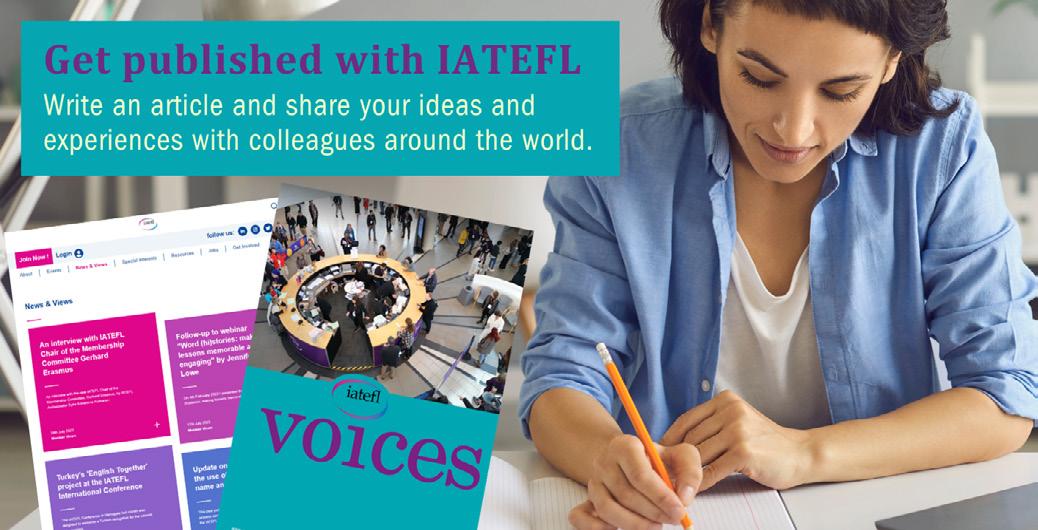
Vanessa Rodrigues Bocchi Barbosa discusses the concept of Positive Discipline and explores how it can be incorporated into the classroom
Teaching requires commitment beyond the content. One should always strive to reduce the distance between what is said and what is done. ‘Freedom matures in confrontation with other freedoms, in the defense of its rights against the authority of parents, teachers, the state’ (Freire, 1996, p. 106). Belonging is achieved through the perception of belonging to a group, not by a simple physical presence, but as an integral and participative part of the whole, taking into account its real importance in the functioning of the interpersonal fabric. The child belongs and responds when he or she feels that his or her participation is important, necessary and valued by the adults (Nelsen, 2017).
It goes without saying that being able to work in a good atmosphere creates more learning opportunities and provides students with a sense of belonging. Nelsen (2017), in the approach proposed by Positive Discipline, explains and details the basic concepts of Adler’s (1956) theory, emphasising the following premises: children are social beings; the child’s behaviour is based on self-created goals; the child’s main goal is to be accepted; a child who does not behave is always a discouraged child; it is necessary to have a sense of social responsibility; the practice of equality is fundamental; all mistakes are learning opportunities; and still, the need to show affection unequivocally.
Positive Discipline is a model of encouragement based on 5 principles:
1 Be firm and gentle at the same time.
2 Make the child feel important and relevant.
3 Be effective over the long term.
4 Teach life skills.
5 Help children develop skills and become aware of their resources. (Nelsen, 2017) All principles are simultaneously important through interdependent approaches in no order of importance.
If we consider the curriculum and the school environment as tools and spaces

Vanessa Rodrigues Bocchi Barbosa has been in ELT for over 20 years. She has a master’s degree in education: curriculum (2021) from PUC-SP, is graduated in Literature (Portuguese and English) and Education and has a degree in Social Communication. She holds the CELT-P and the TKT-YL. She has been a Positive Discipline educator since 2017. She is currently a pedagogical and internationalisation coordinator at Colégio Marista Arquidiocesano in São Paulo, Brazil.
that promote the integral development of the student, we have the need to expand the possibilities in this environment and qualify the interactions between the beings that belong to such an environment. Malaguzzi (1999) teaches us to think about the potential of children and to respect their rights. Moreover, pedagogy must focus on the child as the protagonist and creator of his or her learning, with the teacher acting as a mediator who guides and accompanies the child (Malaguzzi, 1999).
Positive Discipline believes that children learn when they are taught gently and firmly at the same time, without the use of punishment. Its contribution to education is to change the way adults look at children and to emphasise the need to create a culture of respect and belonging in the way people are educated.
We have seen many developments in methods over the years. However, the foundation for a mentally healthy person has never been the focus, as the content of the teaching has always been placed in the foreground in schools. The search for an inclusive curriculum includes the student, which can be achieved through the Positive Discipline approach.
In the context of education through Positive Discipline, the student is always seen as an integral part of the relationship in its totality, deserving respect in treatment, appreciation of language, a sense of belonging and the need for their contribution to the social group. The child is perceived as part of the discourse in a truly equal position; one speaks with them, not about or for them.
The success of Positive Discipline depends, to a great extent, on the mutual
connection and interactivity between the adult and the child in an environment of respect and equality. The application of the Positive Discipline approach depends on the adult learning new skills to help children achieve safety, belonging, acceptance, equality, affection, encouragement and social responsibility, both in childhood and in adult life (Nelsen, 2017).
One of the helpful and practical rules of Positive Discipline is the development of respectful communication skills. This is because development is continuous and the way we communicate can be both a communication barrier and a communication stimulator. Phrases like, ‘This is your fault!’, ‘How many times do I have to discuss this with you?’, ‘When are you going to get your act together?’ are clear behavioural barriers. However, phrases like, ‘I’ve noticed you were uncooperative today. I am interested in hearing your version of what happened.’ ‘Can you think of ways to avoid this problem in the future?’ and ‘If you need help with this problem, let me know. I can think of some ideas.’ stimulate communication. According to Nelson, ‘It is necessary for educators to phrase their sentences in a way that encourages communication in context’ (2017, p. 78). Examples of communication barriers include:
One should not assume what the student thinks, feels or knows. As obvious as it may seem, educators often try to guess what the student knows, thinks or feels without asking. Such a habit leads to missed rare opportunities, as the student may be underestimated or misunderstood without even being given a chance to communicate.
Dreikurs suggested that it is best to never do anything for a child that the child can do on their own (Nelsen, 2017). Exploration is always necessary for the child’s development and therefore the educator must always find ways to provide opportunities and create situations for students to think about themselves
Issue 290 2022
2022 2019 and draw their own conclusions rather than telling them what to do and how to do it.
Like explaining, instructing reinforces a pattern of dependency. Students should be encouraged and involved so that they can all come to conclusions about how to make the classroom a healthier environment for all.
anticipation instead of celebrating
Teachers should have high expectations. But they should also celebrate all successes, even the smallest ones.
Children have priorities that are appropriate for their age group. Therefore, even though adults should be teaching languages, history, science, etc., they should show understanding and respect for other activities such as sports, friends, sleeping, etc. (Nelsen, 2017).
By getting familiar with the principles of Positive Discipline, little by little the teacher starts to benefit from it by gradually building a relationship of mutual respect with the students. Of the many practical ways teachers can:
1 ask rather than explain;
2 suggest limited choices;
3 redirect situations;
4 act without speaking/agree on nonverbal signals;
5 use encouraging phrases;
6 use class meetings with students; and/ or
7 make a connection before correcting.
The possibilities are many. Through daily practice, the teacher will become better at applying the techniques and understanding the reason for the student’s behaviour, making the classroom more productive and welcoming. Positive Discipline offers the opportunity to enhance teacher training while promoting the emotional growth of students and it does this by
developing self-regulation and highly relevant emotional skills for everyone in education.
Adler, A. (1956.) The Individual Psychology of Alfred Adler. Harper. Freire, P. (1996). Pedagogia da Autonomia: Saberes necessários à prática educativa. 25 Edition. Paz e Terra.
Malaguzzi, L. (1999). História, ideias e filosofia básica. In C. Edwards, L. Gandini & G. Forman. As Cem Linguagens da Criança: a abordagem de Reggio Emilia na educação da primeira infância (pp. 59–104). Artmed. Nelsen, J. (2017). Disciplina Positiva: O guia clássico para pais e professores que desejam ajudar as crianças a desenvolver autodisciplina, responsabilidade, cooperação e habilidades para resolver problemas Manole.
vanessa.bocchi@colegiosmaristas.com.br
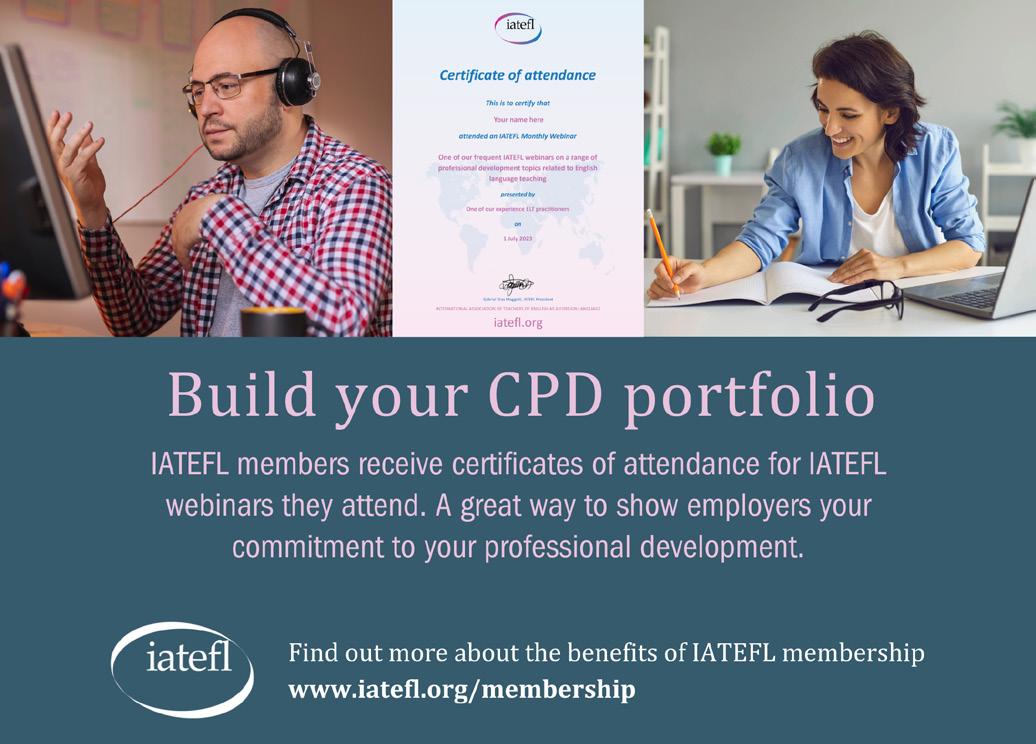
Romina Sabia looks into unlocking the potential of artificial intelligence for personalised learning and encourages educators to take the leap
In my dynamic and ever-evolving role as an English teacher, I have recently embarked on a transformative exploration into the boundless and exciting realm of artificial intelligence (AI). The world of AI, with its innovative technologies and cutting-edge applications, has unveiled thrilling possibilities, promising a more personalised, engaging and collaborative learning experience for my students. Through this reflective article, I am eager to share the enriching experiences AI has brought to my teaching practice and express my unwavering enthusiasm for the ongoing integration of AI in the classroom. My aim is to inspire and empower fellow educators to overcome any apprehensions and embrace the incredible opportunities AI presents for the future of education.
My introduction to AI: a paradigm shift
The moment of my first encounter with AI remains vivid in my memory – it felt like stepping into a new world teeming with limitless potential. As I ventured into the paradigm shift, I incorporated ChatGPT, a sophisticated conversational AI, as my virtual teaching assistant. This AI not only efficiently addressed student queries but also dynamically generated content and provided real-time feedback, infusing a new level of dynamism and personalisation into my teaching approach.
As my exploration of the AI landscape deepened, I discovered specialised history education chatbots like ‘Hello History’ and ‘Próceres.ai’. These digital companions not only facilitated seamless communication but also sparked lively historical discussions, offering my students instant access to a wealth of valuable information. The ease with which these chatbots integrated into my lessons was astounding, opening new and exciting avenues for interactive learning experiences.

Romina Sabia is an ESL Teacher at IES en Lenguas
Vivas Juan Ramón Fernandez. She is a MagicSchool AI Trainer and AI Consultant, and is a member of the Parlamento Mundial De Educación. Romina is also a member of SAIA (Sociedad Argentina de Inteligencia Artificial).
A groundbreaking revelation in my AI journey was the discovery of AI-generated visuals and videos. Platforms like D-ID, dedicated to anonymising facial images and videos, streamlined the management of sensitive student data, revolutionising privacy protection in the digital classroom. This technological marvel proved to be a gamechanger, ensuring a secure and
ethical environment for both educators and students.
Furthermore, the integration of AI-powered tools for image and video generation became instrumental in making complex concepts visually accessible. These tools empowered me to create not just informative but also captivating visuals and animations. This not only simplified intricate topics but also ignited the creative spark within my students. Witnessing the sheer excitement in their eyes as AI breathed life into their ideas was not only fulfilling but also a testament to the transformative power of AI in the educational landscape.
AI paved the way for groundbreaking interdisciplinary projects that transcended conventional educational boundaries.

Issue 290 2022
2022 2019
Engaging virtual reality (VR) museum tours, such as Google Arts & Culture VR, not only provided a visual feast for my students but also transported them to distant art galleries and historical landmarks. These immersive experiences went beyond traditional teaching methods, enriching their understanding of art, history and culture and fostering a deep sense of curiosity and appreciation.
Additionally, I harnessed the vast potential of robotics by incorporating telepresence robots and drones into my teaching toolkit. This allowed my students to embark on virtual expeditions into the ocean depths, explore the mysteries of outer space and visit historical sites – all from the comfort of our classroom. The palpable thrill of embarking on such educational adventures sparked a sense of wonder and curiosity that transcended traditional learning boundaries, creating a truly immersive and memorable learning experience.
My journey into the AI world has been nothing short of transformative. I’ve witnessed first-hand the power of AI to create personalised, engaging and collaborative learning experiences. As I look to the future, I’m more enthusiastic than ever about continuing to implement AI in my classroom.
But I don’t want this journey to be mine alone. I want to encourage my fellow educators not to be afraid of having a go.
The world of AI may seem daunting, but the opportunities it offers are boundless. Embracing AI is not about replacing teachers; it’s about augmenting our capabilities and enhancing the educational experience for our students.
In conclusion, my exploration of the AI landscape has proven to be an exhilarating journey, marked by continuous discovery and profound transformations in the educational landscape. I am steadfast in my commitment to delve even deeper
into the vast potential that AI holds for education. With an unwavering dedication to exploring its capabilities to the fullest, I am fuelled by the belief that our foray into AI is a collective effort that extends beyond the confines of my own experiences.
I extend a heartfelt invitation to educators far and wide, urging you to embark on this invigorating path of innovation and personalisation alongside me. Together, we have the power to shape a future for education that is not only brighter but also more engaging and responsive to the diverse needs of our students. Let us unite in this exciting venture, creating a collaborative space where learning transcends traditional boundaries. In our shared commitment to excellence, we can build a classroom environment where the potential for every student to flourish knows no bounds.
rominasabia@gmail.com
Seda Yaman outlines various techniques and strategies that can be used to build student confidence in class
Introduction
Learning a new language unlocks a world of possibilities for personal growth and connection with others. However, learning a new language can be a hard nut to crack for some people. I have been teaching English to students aged 4–40 years old for almost 10 years. I have observed that language learning is not only about memorising vocabulary and mastering grammar rules; it’s a lifelong journey that involves the development of essential skills and, perhaps most importantly, the cultivation of self-confidence. In my article, I would like to point out ways how learners can build self-confidence to be better at language proficiency.
Over the years, it has been very surprising to see that having selfconfidence matters a lot in reinforcing a

Seda Yaman is a passionate English teacher/teacher trainer living in Turkey. With a strong background in language development in early childhood, curriculum development and communicative skills in English, she has dedicated her career to empowering young learners and promoting innovative teaching practices.
sense of accomplishment. I have realised that those with less confidence but more knowledge usually struggle to express themselves in English. They may be perfectionists. On the other hand, those with overconfidence can start talking without thinking about fluency or accuracy. I believe setting achievable and realistic language learning goals is crucial for building confidence. If you start by breaking down larger language objectives into smaller, manageable tasks, it will give the learner a sense of achievement and sustain motivation during the language learning process.
Another important factor is to create a supportive and encouraging learning environment. As a teacher of young learners, I have observed that parents can put too much pressure on their kids in order to get quick results. We, as teachers, need to encourage a space where learners feel comfortable taking risks and making mistakes. We must foster peer collaboration, group activities and open communication to build a sense of community within the language learning space. This supportive atmosphere can enhance learning and confidence. Positive reinforcement and constructive feedback are essential. We need to highlight what learners are doing well and offer guidance on areas for improvement.
We also need to encourage a growth mindset, emphasising that mistakes are an essential part of the learning process. This approach cultivates resilience and a positive attitude towards learning a new language. According to Aydin and Tekin
(2023, p. 1), ‘the use of positive psychology elements effectively enhances foreign language enjoyment, decreases foreign language anxiety, and develops basic language skills’. Positive reinforcement plays a significant role in this process. By recognising and celebrating students’ efforts and progress, teachers can foster a sense of accomplishment and motivate students to continue striving for improvement.
Constructive feedback, on the other hand, helps students understand areas where they can grow, making them more willing to engage in challenging tasks without the fear of failure.
Fostering peer collaboration and open communication within the classroom builds a sense of community, which further enhances the learning experience. When students feel supported by both their teachers and peers, they are more likely to actively participate and take ownership of their learning journey.
Confidence in speaking can be a significant barrier for language learners. Starting from young learners to teenagers, schools must integrate regular speaking practice into lessons through role-playing activities, debates or casual conversation sessions. In my own classes, I’ve found that incorporating role-playing activities is particularly effective with younger students. For example, when teaching vocabulary related to shopping, I set up a mock store where students can practise asking for items, make purchases and engage in polite conversation. This type of activity not only helps them practise their speaking skills but also builds their confidence in using the language in real-life scenarios.
For teenagers, debates have proven to be a great way to develop their speaking abilities while also encouraging critical thinking. In one class, we held a debate on the pros and cons of social media. Students were tasked with preparing arguments and counterarguments, which they then presented to the class. This activity not only improved their fluency but also helped them become more comfortable with public speaking.
Casual conversation sessions are another strategy I’ve used to reduce speaking anxiety. For instance, I sometimes start a lesson with a ‘conversation circle’ where students discuss a topic of their choice. This informal setting allows them to express
their thoughts freely without the pressure of being formally evaluated.
The more learners engage in real-life language use, the more confident they become in expressing themselves. ‘Effective treatments to improve language learning confidence are needed for optimal results’ (Ghafar, 2023, p. 55). This practical approach helps bridge the gap between learning the language and using it effectively in real-world situations. As a part of this, incorporating authentic materials such as movies, songs and articles into the curriculum is invaluable. Exposure to real-world language use builds confidence by demonstrating the practical application of language skills. Discussing and analysing authentic content also enhances critical thinking abilities, making the learning experience more engaging and relevant. For example, I’ve used news articles in my classes not only to teach new vocabulary and grammar but also to spark discussions on current events. After reading an article, students participate in a discussion where they express their opinions and analyse the content. This not only improves their language skills but also enhances their critical thinking as they consider different perspectives and formulate arguments.
Another effective method is the use of podcasts. I’ve assigned episodes from language-learning podcasts that feature interviews with native speakers on various topics. After listening, students summarise what they’ve heard, discuss key points and even role play parts of the interview. This exposes them to natural speech patterns, idiomatic expressions and the rhythm of the language, which boosts their confidence when speaking. I’ve also incorporated video content, such as short documentaries or interviews, into lessons. For example, after watching a documentary segment, students might work in groups to analyse the content, discuss the key themes and present their findings to the class. This not only engages them with the language but also makes the learning experience more relevant by connecting it to real-world issues.
Every student is unique and each may have a different learning style. Diversifying learning resources to accommodate different learning styles is crucial. Visual aids, audio materials, interactive apps and written texts appeal to a range of preferences, ensuring that learners can access information in ways that resonate with them. This approach enhances
engagement, understanding and retention, catering to the diverse needs of language learners. For visual learners, I’ve used infographics and colourful charts to break down complex grammar rules. For instance, when teaching verb tenses, I created a visual timeline that mapped out each tense with examples. This helped students visualise the concept and made it easier for them to grasp the differences between past, present and future tenses. For auditory learners, I’ve incorporated podcasts and songs into lessons. When covering topics like daily routines, I’ve assigned podcast episodes that aligned with the vocabulary we were studying. Additionally, I’ve used songs to reinforce grammatical structures, like playing a song that highlights different prepositions and then getting students to identify them in the lyrics.
To engage kinaesthetic learners, I’ve used role-playing activities and interactive games. For example, in a lesson about ordering food, I set up a mock restaurant where students had to take turns being the waiter and the customer, practising their conversational skills in a fun, real-life scenario. I’ve also incorporated interactive apps like Kahoot! to create quiz-based games that encourage movement and participation. For reading and writing learners, I’ve assigned journalling tasks and reading comprehension exercises. In one unit, students kept an English journal where they wrote daily entries about their experiences, using the vocabulary and grammar we were covering in class. I’ve also used short stories and articles followed by comprehension questions to deepen their understanding of the material.
For social learners, I’ve facilitated group discussions and peer-teaching sessions. After introducing a new topic, I often break students into small groups to discuss the material, share their perspectives and teach each other. This collaborative approach not only reinforces their understanding but also builds their confidence in using the language. For logical learners, I’ve used grammar puzzles and problem-solving activities. For example, I introduced sentence diagramming exercises where students had to break down sentences into their grammatical components. I’ve also used logic-based activities like crosswords and riddles to make learning grammar more interactive and challenging. These approaches help ensure that all students, regardless of their preferred learning style, can engage with the material in a way that resonates with them, ultimately enhancing their overall learning experience.
Issue 290 2022
2019 Conclusion
Building confidence in language learning is a multifaceted process that requires careful attention to various aspects of the learning environment. Creating a positive and supportive atmosphere is foundational, as it encourages learners to take risks without the fear of failure. When students feel safe and supported, they are more likely to experiment with the language, make mistakes and learn from them, a critical component of developing language proficiency. Setting realistic goals is another essential strategy. By breaking down the language acquisition process into manageable steps, educators can help learners experience success at each stage, which reinforces their confidence and motivates them to continue progressing. These goals should be
tailored to the individual needs and abilities of each learner, ensuring that they are both challenging and achievable.
Embracing a growth mindset is equally important. This approach helps learners understand that their abilities are not fixed but can be developed through effort, persistence and practice. When students believe that they can improve over time, they are more likely to approach language learning with resilience and determination, viewing challenges as opportunities for growth rather than as obstacles. By implementing these strategies, language educators empower learners to overcome the inherent challenges of language acquisition. As students become more assured in their abilities, they not only improve their language skills but also develop the confidence to navigate the complexities of communication in realworld situations. Ultimately, this holistic
approach enhances overall language proficiency, equipping learners with the tools they need to succeed in both academic and everyday contexts.
Aydin, S., & Tekin, I. (2023). Positive psychology and language learning: A systematic scoping review. Review of Education, 11(3). 1–27. doi.org/10.1002/ rev3.3420
Ghafar, Z. (2023). The Influence of Self-Confidence on English Language Learning: A systematic Review. International Journal of Applied Educational Research, 1(1). 55–68. dx.doi.org/10.59890/ijaer.v1i1.452
sd_ymn@hotmail.com
Ahisha Haneef approaches the subject of empowerment through the adoption of a projectbased approach that encourages and empowers students to participate in real-world challenges
Introduction
The growing recognition of global challenges calls for a transformation in education to cultivate a broader awareness. This article examines the incorporation of project-based learning (PBL) into English Language Teaching (ELT). Inspired by the British Council’s Primary Plus magazine My Music, the project tasked students with designing soundproof ear mufflers, aligning with the principles of project-based learning (PBL).
The central inquiry question driving the project was, ‘How can we assess primary learners using PBL applicable across all contexts?’
PBL sessions not only address language learning but also nurture crucial 21st-century skills: critical thinking, problem solving, communication, collaboration, digital proficiency, creativity, imagination, and leadership. The project

exemplifies how language learning extends beyond the classroom, empowering students to contribute to real-world challenges.
By sharing this experience, I aim to inspire fellow educators to enrich their ELT curriculum, integrating meaningful content and fostering a generation of language learners with a heightened sense of responsibility.
The British Council’s statement of approach emphasises learner-centred methodologies, realistic goal-setting, reflection, constructive feedback and assessment strategies. This aligns seamlessly with the project’s framework, providing a solid foundation for meaningful learning experiences.
The focus on preparing students for college and careers extends beyond traditional academic subjects, emphasising attitudes, habits and skills crucial for success. A significant study (Conley, 2005) identified key ‘habits of mind’, including critical and analytical thinking, problem solving, openness to feedback and failure, effective communication, source evaluation, independent reasoning and time management. Employers similarly emphasise critical thinking, problem solving, effective communication, real-world application of knowledge, information handling, innovation and teamwork. These skills, collectively known as ‘success skills’, go beyond basic subject knowledge, highlighting the need for a comprehensive educational approach that instils these competencies (Larmer et al., 2015). Project-based learning (PBL) encourages students to explore realworld problems, promoting active engagement, critical thinking and collaboration. The integration of PBL in language teaching has shown promising results in enhancing language skills and fostering 21st-century competencies.
Seymour Papert’s pedagogical approach built on Piaget’s theory of constructivism with a learning theory of his own: constructionism proposes that the best way to ensure that knowledge is built in the learner is through the active construction of something shareable – a poem, program, model or idea. In other words, hands-on experiences and problem solving (Stager, 2016). The project draws inspiration from Papert’s principles by engaging students as active participants in solving challenges.
The project methodology followed a systematic approach to address the challenge of sound pollution in Colombo, the commercial capital of Sri Lanka. Initially, the challenge was presented and defined, framing students as sound engineers. This introduction was facilitated via a YouTube video and subsequent person-aligned discussions to create a context for engagement.
Following that, the project emphasised teamwork by assigning roles within the team, promoting collaboration, negotiation and boosting confidence as students stepped into the shoes of sound engineers. The research phase employed a KWL grid (What I Know, What I Want to Know, What I Learned) to guide students in exploring their existing knowledge, identifying gaps, and documenting new insights.
Various activities then followed, aimed at raising awareness of the students’ surroundings based on the research findings, including aspects such as decibel levels and conductors of sound. The design and testing phase involved the creation and evaluation of prototypes, followed by an iterative process of improvement based on feedback. This cycle was repeated to enhance the prototype further and ultimately produce the final product, which was then retested for effectiveness.
Throughout the course of the project, a record was maintained to capture the new language learned as students engaged in various aspects of the project. Finally, the methodology included a reflective component, allowing students to contemplate and analyse their experiences, learning, and contributions to the project, fostering a holistic understanding and application of the language and skills.
Various formative assessment techniques, including peer-feedback, self-assessment, exit tickets and KWL grids were employed to gauge language proficiency and measure students’ understanding of global issues. These techniques also helped assess the students’ ability to propose sustainable solutions effectively.
The project’s culmination involves valuable feedback and reflection, emphasising the inquiry process. Student testimonials highlight increased awareness of sound-related environmental issues, new vocabulary acquisition and the collaborative nature of the project. These reflections serve as evidence of the successful integration of real-world problems into the ELT curriculum.
Furthermore, the project portfolios provide exemplary models for teacher training. Educators attending sessions on this project report feeling inspired, recognising the potential of integrating PBL into their language teaching practices.
This holistic learning approach showcases that students can autonomously address challenges when provided with opportunities to tap into their creativity and interests.
Conley, D. T. (2005). College knowledge: What it really takes for students to succeed and what we can do to get them ready. Jossey-Bass.
Larmer, J., Mergendoller, J., & Boss, S. (2015). Setting the Standard for Project Based Learning. ASCD.
Stager, G. (2016). Seymour Papert (1928–2016). Nature, 537, 308. doi. org/10.1038/537308a
Ahisha.Haneef@britishcouncil.org

In the first of two lesson plans in our For the Classroom section, Mohamed Ramadan presents a lesson on productivity and how to be more productive

Mohamed Ramadan has been teaching English to adults for over 25 years in Egypt and Kuwait. He holds a master’s degree in educational psychology with a focus on brainbased learning and is currently working as an ELT supervisor in Egypt.
Lesson objectives
By the end of the lesson, students will be able to:
❚ define productivity and explain what it means to them
❚ reflect on and describe their most and least productive days
❚ identify factors that make them less productive
❚ develop tips for how to be more productive in their lives.
Student profile
❚ 10th-graders (12–14 years old) or older
Materials needed
❚ sheets of paper and pens
❚ handout (figures 1–5 below)
❚ dictionary
❚ photos that show the meaning of the word ‘productivity’, e.g. people hard at work or studying
Lesson plan
Activity 1: Opening activity (What ‘productivity’ is) (10 mins)
❚ Students receive the productivity handout (Figure 1) from the teacher.
❚ The teacher writes the word ‘productivity’ on the board. The teacher also shows photos that exemplify productivity.
❚ The teacher asks students what productivity means to them and gets them to brainstorm their ideas.
❚ The students brainstorm and note down their ideas. The teacher can write key ideas and themes on the board while monitoring the brainstorming activity.
❚ The teacher discusses with the class the common themes from their ideas and then writes a class definition of productivity on the board, which the students copy onto their handouts.
Brainstorming productivity Ideas:
Activity 2: Defining ‘productivity’ using the dictionary (10 mins)
❚ The teacher asks students to work in pairs to define the word ‘productivity’ using the dictionary.
❚ The students write the dictionary definition onto their handouts (Figure 2).
❚ The teacher then facilitates a discussion to compare the definition of productivity from the initial class discussion and the definition provided by the dictionary.
❚ The teacher elicits from students the key elements of the dictionary definition and asks students to write two of them on their handouts.
Defining productivity
Productivity according to the dictionary is:
Definition key elements
Key elements of the dictionary definition are:
Figure 2: Productivity handout part 2
Activity 3: My most and least productive days (15 mins)
❚ The teacher asks students to describe their most and least productive days.
❚ Students individually write in their handouts short reflective descriptions for each day (Figure 3).
❚ The students then share their descriptions with the rest of the class.
❚ The teacher facilitates discussion on the factors that contributed to the level of productivity.
Describe your most and least productive days. Most productive day:
Least productive day:
Figure 3: Productivity handout part 3
Activity 4: What makes me less productive? (15 mins)
❚ Students make a mind map identifying factors that make them less productive (e.g. distractions, lack of motivation, etc.).
❚ In small groups, students discuss and compare their mind maps. Each group then reports back to the rest of the class the factors they had in common.
❚ The teacher asks students to write individually on their handouts the factors that make them less productive (Figure 4).
Factors that make me less productive Distractions:
Lack of motivation:
Other factors:
4: Productivity handout part 4
Activity 5: Tips for productivity (20 mins)
❚ Using their mind maps and notes on their handouts so far, students write some tips for improving productivity (Figure 5). The handout includes at least 3 tips for being more productive in life and school.
❚ Students share their tips with the class.
Tips for improving productivity
Figure 5: Productivity handout part 5
Closing activity (5 mins)
❚ The teacher reminds students of the lesson objectives.
❚ The teacher asks students to reflect on their learning on the handouts.
❚ The teacher asks some students to summarise the key learning points.
Homework assignment
The teacher asks students to write an essay of around 500 words about ‘How to be more productive in your life’ based on the notes on their handouts.
eltguide@gmail.com
In our second lesson plan, Ignacio González presents vocabulary related to natural disasters in the context of global warming

Ignacio González is an EFL teacher and trainer from Caracas, Venezuela. He holds a master’s degree in applied linguistics and recently completed his DipTESOL diploma. He also holds the Cambridge CELTA and TYLEC qualifications. Ignacio actively participates as a frequent speaker and contributes his expertise at both national and international conventions, such as VenTESOL, BBELT and TESOL international. He is currently training primary school teachers and teaching at the British Council in Caracas, Venezuela.
By the end of the lesson, students will be better able to recognise and produce vocabulary about natural disasters in the context of global warming.
❚ 10–11-year-old students or younger (CEFR A1)
❚ whiteboard and markers
❚ projector
❚ PowerPoint slide with six images of different natural disasters
❚ worksheet for matching the natural disaster vocabulary to the appropriate image
❚ coloured pencils and paper or notebooks
plan
Activity 1: Lead in (5 mins)
On the board, the teacher draws a high-rise building that is going to be hit by a big wave, as in Figure 1 below. On top of the building, a person is asking for help. The sun is strong and intense.

The teacher asks the students, ‘What is the problem?’ eliciting that it is the tsunami (or the big wave), the sun, the person that are the problem. The teacher then asks, ‘What is the problem with the sun?’ The students can answer, for example, that the sun is angry or that global warming is the problem. The teacher can explain that the tsunami is a product of global warming.
Activity 2: Presentation (meaning, form and pronunciation of the target language) (10 mins)
The teacher tries to elicit some other natural disasters and adds them to the original drawing on the board, for example, flood, tornado, storms, wildfires or rising sea levels. The teacher writes the names of the natural disasters next to each drawing and provides the pronunciation using quick choral drills. As an alternative, the teacher can nominate students and they can go to the board and draw the natural disasters.
Activity 3: Practice (10 mins)
Part 1
The teacher shows the slide with the six different pictures of the natural disasters. These photos can be prepared in advance and can be the same/similar to those that came up in the previous activity. The learners have one minute to memorise them. Playing Kim’s game, one of the pictures disappears and the students
2019 have to name the natural disaster that disappeared. The process is repeated to check all natural disasters and the teacher provides error correction on stress and pronunciation. The teacher can also check the spelling of each lexical item, for example: ‘How do you spell flood?’
Part 2
The teacher provides a worksheet where the students match the name of the natural disaster with its picture. Fast finishers can organise the natural disasters from the most to the least dangerous.
Part 1
Working individually, students draw a city where two or three natural disasters are affecting the place. The teacher needs to highlight the fact that the learners cannot show their drawings to their classmates. Students have just five minutes to create their drawings. When monitoring, check that the learners include the disasters and do not waste too much time with other details. Push learners who are running late, for example, ‘two minutes to finish’. Check that students understand the task by asking, ‘Are you drawing or colouring?’ [Drawing] ‘Are you showing your picture to your classmates?’ [No] Fast finishers can add extra items to the city such as cars, animals, etc. and write the names of those items next to them.
Part 2
The teacher then groups the students into pairs. Student A
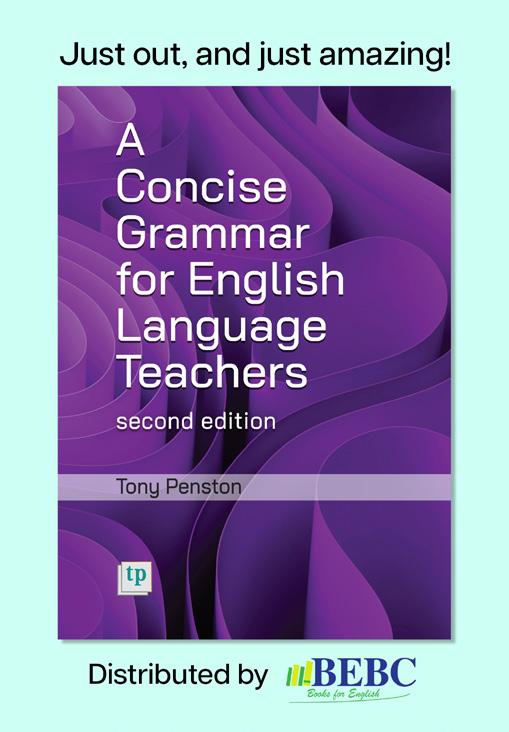
describes their picture including the natural disasters to Student B. On a different piece of paper, Student B listens and tries to draw what Student A is describing. Then the process is switched round so that Student B takes a turn to describe their drawing. Monitor the process and can help where necessary.
The teacher can provide the following prompt on the board to help learners when they are describing their pictures.
In my city, there is/are __________________.
The teacher can use this prompt to provide the following example sentences:
❚ In my city, there is a person.
❚ In my city, there is a building.
Once they finish, they can compare their pictures to see what is the same and what is different. Each pair can report back to the class on the similarities and differences. If there is enough time, students can add further details and colour to their drawings.
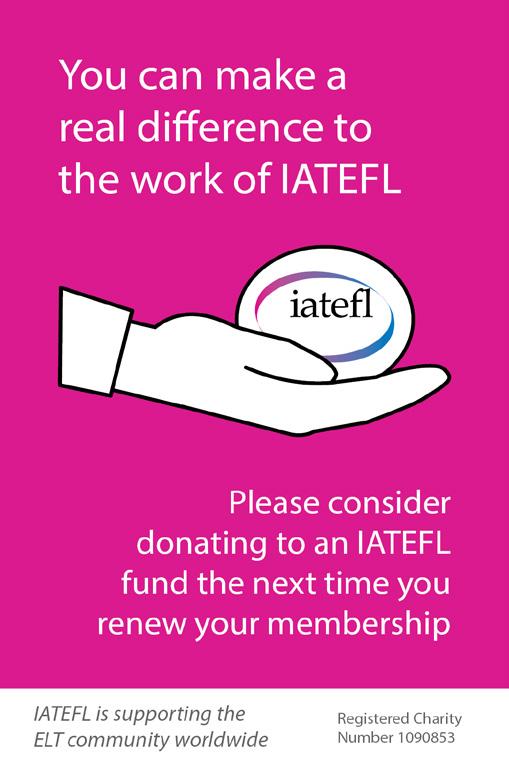
Edited by Saskia Kersten and Christian Ludwig
Multilingual Matters, 2024 280 pages
eBook (ePub) ISBN 9781800414822 www.multilingual-matters.com/page/ detail/?k=9781800414822

Despite the well-known fact that digital culture shapes how language learners and teachers interact and make meaning, English language education remains largely focused on print text and print media, and the reality of the growing importance of born-digital texts in learners’ lives is often ignored. This book in sixteen chapters is the first to focus specifically on born-digital texts in EFL teaching. The book originates from The Born-Digital Text Symposium which took place online in January 2021, and it provides a theoretical framework for designing curriculum, materials and methods, integrating innovative scholarship and practical classroom applications.
The authors argue that the literacies necessary to consume and produce texts should include both born-digital and traditional print-related literacies. They explain their understanding of the text and identify the characteristics of digital culture, such as referentiality, community and algorithmicity. In their examples of research and insights from classroom practice, IT literate teachers become consumers and producers of computerbased materials, and the new circumstances sometimes lead to reversing the novice and expert roles in the classroom but also to new possibilities for differentiation and scaffolding for Special Educational Needs (SEN) students.
In this book, we can learn how the hashtag provides learners with linguistic, communicative and discursive learning opportunities; how algorithms impact the creation of filter bubbles on Instagram; the benefits and challenges of using live text; about videos as mediation tasks; and about learning English on social media using discussion groups and assessment chat sessions. The affordances of artificial intelligence-generated texts are presented through research results as well as examples of the teaching of their mindful consumption and production. The book changes perceptions of writing and reading instruction, with the ideas of how to enrich the reality of classroom writing and reading by uncoupling the idea of the book from ‘paper thinking’.
The book sheds light on how digital technology can enhance literature teaching, assessment and reflection, with chapters on fanfiction, other examples of narratives that rely on the digital format, location-based technologies and mobile-assisted language learning activities. These elements of popular participatory culture are explained, with examples of activities and communities that can help teachers align their students’ interests and curriculum content.
If you are looking for a resource that will inspire you to incorporate more born-digital texts in your teaching, provide research and examples of good practices and offer valuable ideas on how to proceed with learning about born-digital texts in language education, this book is highly recommended.
Sanja Božinović EFL teacher and teacher adviser sanja.bozinovic@skole.hr
Alessia Cogo, Graham Crookes and Sávio Siquiera
DELTA Publishing, 2023
168 pages
ISBN 9783125017436 www.deltapublishing.co.uk/book/englishfor-a-critical-mind-9783125017436/
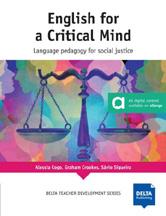
New ELT books rarely excite me as much as this one. The two areas that have most interested me in recent years combined in one book: Critical Language Pedagogy (CLP) and English as a Lingua Franca (ELF).
I decided that the best way to get my head around both the background concepts and the practice was to use the sample materials myself. I had just the group in mind: a class of female teachers from Sudan, now, due to the war, living either in Port Sudan or Egypt, who I taught once a week via Zoom and WhatsApp. It would have been far easier face-to-face, but the tools suggested for handling participation, e.g. self-reporting worksheets and the ‘rotating chair’ pattern (p. 45), helped.
The book starts with several clear definitions and discussions of the basic concepts involved: Critical Pedagogy, CLP, language, critical learning and ELF. This is very much based in reality, for example, stating that students may question the idea of negotiating a syllabus as ‘their educational socialisation may not make it easy for them to take an active role in deciding what to learn’ (p. 37). One of the most useful ideas here for me was the provision of different attitudes and techniques for critical dialogue, with five different language tools to enable talk to ‘have a truly critical dialogic nature’ (p. 41): hypothetical talk, metaphorical talk, intertextuality, problematising the text and the language of critique.
The two areas, CLP and ELF, are then brought together in practical discussions on how these might look in the classroom. Various suggestions, all with very clear examples, include focusing on linguistic landscapes, e.g. bringing T-shirts to class with text on to analyse; getting students to collect data, e.g. online videos or resources in ELF; looking at public signs that mix English with local languages, e.g. by code-switching, and the subversive use of translanguaging.
The teachers in my trial group at first found it very difficult to accept that there were no right answers. Little by little, however, the structure of the materials, together with the tools provided, really helped all of us start to understand. And it is just a start: the more we read, discussed and thought, the more we realised we needed to read, discuss and think more. Hence, the need for the final third of the book, on teacher reflection, challenge of action and building a teacher network.
I feel this book would be best suited to teachers with experience. So, if you’re looking for new challenges and complex areas to question, invest in this book and it will be an excellent guide.
Linda Ruas Teacher, trainer and consultant lindaruas@hotmail.com
To follow on from the feature articles that focused on empowerment, IATEFL Voices editor Derek PhilipXu asked the Special Interest Groups to outline what empowerment means to them and how they empower their teachers and educators. Here’s what LTSIG, BESIG and ESOLSIG had to say.

LTSIG: empowering members through learning technologies
Professional development empowers teachers by boosting confidence and enabling them to act on ideas and influence their professional environment. This empowerment involves engaging in and influencing events that affect their lives. Empowerment enhances leadership skills and improves student outcomes. Effective teaching requires a blend of knowledge, skills and personal qualities. Teachers pursue development to expand their expertise, which is motivating for both new and experienced educators and LTSIG always seeks to support teachers’ development.
The IATEFL Learning Technologies SIG (LTSIG) is dedicated to empowering its members by providing resources, support and opportunities for professional growth in the rapidly evolving field of educational technology. With a focus on language teaching, LTSIG ensures that educators are equipped with the tools and knowledge needed to integrate technology effectively into their classrooms.
LTSIG offers a variety of professional development opportunities, both online and face-to-face, including workshops, webinars and conferences. These events feature experts in language teaching and technology who share the latest trends and best practices. Members gain handson experience with innovative tools, learning how to apply them in diverse teaching contexts. This continuous learning environment helps educators stay current and enhances their teaching effectiveness.
Our members also have access to an extensive online library of resources including research articles, through the pages of our newsletters and videos from webinars and conferences. These resources are curated to support educators in selecting the best tools for their specific needs. LTSIG also provides tutorials and guides to help members navigate new technologies, ensuring that they feel confident and competent in their implementation.
LTSIG offers great networking opportunities to its members and fosters a vibrant community where members can connect and collaborate. Through online forums, social media groups and local meetups, educators share experiences, discuss challenges and exchange ideas. This network of peers provides invaluable support, enabling members to learn from one another and build meaningful professional relationships.
With a diverse membership spanning multiple countries, LTSIG embraces a global perspective on language education, actively advocating for the integration of technology in language education at both local and international levels. By representing the interests of its members in educational events, and different collaborations around the world, the association ensures that their voices are heard and their needs addressed. This advocacy work helps create a more supportive environment for technologyenhanced language teaching. The association celebrates cultural diversity and encourages the exchange of ideas across borders. This international outlook enriches the professional lives of members and broadens their understanding of language teaching in different contexts.
The IATEFL Learning Technologies Special Interest Group empowers its members by offering comprehensive support and fostering a community of innovation and collaboration. Through professional development, access to resources, advocacy and personalised support, LTSIG ensures that educators are wellequipped to navigate the challenges and opportunities of technology-enhanced language teaching. By joining LTSIG, members become part of a forwardthinking movement that is shaping the future of language education.
Maria Diakou LTSIG Coordinator

There are several definitions of empowerment but some of the ones that best fit language teachers today include having confidence to make decisions and complete the tasks we have set out to do. Those of us working in the field of business English often need to examine the situations we are in and learn to find ways to feel empowered and able to make the choices best for us and our learners.
For the most part, business English teachers are freelancers working in adult education or they have part-time or full-time jobs in academic institutions. We are often tasked with administering needs analysis, creating our own curricula, adapting what we do in the classroom to our learners’ pressing needs and keeping up with the latest trends and information about the fields we work in. In addition, we often have to search for CPD opportunities and be ready to negotiate our own contracts and working conditions.
IATEFL BESIG has been there for business English teachers for almost forty years. We have been running our own face-to-face conference for the last 36 years and bring together business English teachers from around the globe. Our programmes always highlight a variety of topics, we include social events at the conference to encourage delegates to meet new people, mingle, network and become part of the BESIG community.
In addition to our own conference, we hold events at the Annual IATEFL Conference including a PCE and the Showcase Day. We do our best to meet up with members during the Conference and find time to chat with them and get to know them. This is all part of forming a community of practice allowing people to set up a supportive network for themselves.
Our monthly online events deal with topics important to our members. This includes classroom practices and ideas, tips for working as a business English trainer, information about setting prices and gaining clients. All of these opportunities help our members hone their skills and offer resources and support to benefit their careers and reach their goals.
The other support we offer to members is through our social media channels. We are active in this regard and have open groups which anyone can join. From time to time, we run moderated discussions on particular topics and group members can feel free to ask questions and get answers from colleagues. We see these social media outlets as possibilities for members to gain support from those in similar situations and feel that they are extremely important for those who take part.
During the Covid lockdown, IATEFL BESIG began an initiative called ‘The Break Room’ to allow members and non-members to meet with like-minded colleagues in a casual setting. This online Zoom chat is offered twice a month and hosted by a member of the committee.
In conclusion, IATEFL BESIG sees its mission as linking, developing and supporting business English teaching and teachers worldwide, the basics for encouraging empowerment of everyone involved in the field.
Marjorie Rosenberg and Sarah Plochl BESIG Joint Coordinators

Our Special Interest Group (SIG) is dedicated to fostering a global community of English for Speakers of Other Languages (ESOL) practitioners committed to empowering their learners, who are mostly immigrants, refugees and asylumseekers, who have relocated into an English-speaking country. We believe that language education is a powerful tool for personal and societal transformation, and our work is centred on providing resources, support and inspiration to those on the front lines of ESOL teaching.
A cornerstone of our efforts is our free webinars for SIG members, designed to offer continuing professional development. These virtual sessions delve into cuttingedge methodologies and best practices, with the aim to equip practitioners with the knowledge and skills to create engaging and effective learning environments. Recent webinars have been about the innovative use of cinematic narratives to enhance language acquisition and the importance of social-emotional learning for students with interrupted formal education. Beyond our digital endeavours, we actively engage with the ESOL community
Key promotion strategies for your association’s EFL events
Summertime is the period in which many associations take a well-earned break from running workshops, seminars and conferences. So, I thought I would write an article about a topic that I know that many of us feel strongly about – promoting your association’s events.

Teacher associations (TAs) which are eligible to become IATEFL Associates are non-profit and are run by volunteers. This usually means that, apart from sponsorships and occasional government grants, most associations rely on membership fees and membership attendance at events for their funding. Therefore, it is of paramount importance for the association to build a good
membership base and run events which are useful, relevant and enjoyable. As a result, promoting a teacher training workshop or seminar effectively is essential to ensure maximum attendance and engagement. As EFL professionals are often pressed for time, an association’s promotional strategy needs to be targeted, compelling and convenient.
Identify and understand your audience Start by pinpointing the specific needs and interests of your target audience – EFL professionals. Are they seeking innovative teaching strategies, classroom management tips or the latest in language assessment tools? Perhaps survey or poll the members to find out what these interests are. Then tailor the event to meet these needs. In addition, highlight how attending will benefit the members’
through face-to-face events. Our last Pre-Conference Event (PCE) in Brighton in April 2024 brought together educators from diverse backgrounds to share experiences, collaborate and explore new approaches to teaching English outside of traditional classroom settings. These out-of-classroom programmes can serve as vital lifelines for learners, providing not only language instruction but also essential support services such as job placement assistance, mental health counselling and literacy support. Through the promotion of innovative teaching methods and the advocacy of the ESOL students’ needs, our SIG strives to create a world where language is no longer a barrier to opportunity. It is one of our commitments to equip educators with the tools and knowledge they need to excel in their roles and to inspire learners to reach their full potential.
The belief that every learner deserves access to high-quality ESOL education drives our work. We cordially invite you to join our community and contribute to our shared mission of transforming lives through English teaching and learning.
Vivi Bairami ESOLSIG Coordinator
professional development and address the needs and interests.
The association’s promotional message should clearly show the value of the event. Use action-oriented language that emphasises benefits for attendees. For example, instead of simply stating ‘Learn new teaching methods’, try ‘Transform your classroom with cutting-edge teaching techniques that engage and inspire your students’.
Leverage multiple channels and visual modes
Visuals are powerful tools for engagement. Create eye-catching flyers, infographics and short video teasers that highlight key aspects of the workshop. Ask speakers to record 30-second introductions to their sessions and post these. Alternatively, post flyers with photos of the speakers and 30-word blurbs about the session. Showcase testimonials from past attendees or a sneak peek of the workshop content to generate excitement.
Use a mix of communication channels such as email newsletters, social media platforms (LinkedIn, Facebook groups, X) and the association’s website to reach as many members and potential members as possible. Collaborate with local schools, universities and language institutes to share the event details through their networks. This can be achieved by sending out digital posters and flyers which can be easily forwarded to the staff/members/ employees of these establishments. Engage through webinars and social media Q&A
Host a free pre-event webinar or live Q&A session on social media to discuss the workshop’s content. This not only builds interest but also allows potential attendees to ask questions and see the value of the training first-hand. If previous workshops have been successful, share testimonials or case studies from past participants. Real-life success stories can be persuasive in convincing potential attendees of the workshop’s value.
15–18 Shizuoka, Japan
50th Annual International Conference – The Japan Association for Language Teaching (JALT)
‘Moving JALT into the future: opportunity, diversity and excellence’ https://jalt.org/conference
16 University of Cyprus, Nicosia, Cyprus
‘A new teaching era: pedagogical arguments in language teaching and learning’ https://cytea.weebly.com/future-events.html
22–24 Trig Wied Ghollieqa, Malta
37th Annual IATEFL BESIG Conference https://www.iatefl.org/events/554
Before and after
Incentivise early registration with discounts or special offers if the event has an attendance fee. Group rates can also encourage schools or institutions to send multiple teachers. However, even when there is no additional fee for the event, requiring early registration creates a sense of urgency and makes it easier for teachers to commit to attending. As the event date approaches, send out reminder emails and social media posts, including key details like date, time and location, and encourage last-minute registrations. Highlight any remaining spots to create a sense of exclusivity.
After the workshop, send a follow-up email thanking participants and sharing any additional resources or recorded sessions. Certificates of attendance are often very welcome, especially when teachers can use them to show evidence of CPD. Also, posting a
short video (30 seconds to a minute) of highlights of the event on social media is a visually pleasing way to both remind attendees of how enjoyable it was and also to generate interest in future events. Encourage attendees to provide feedback and share their experiences as these can be used to promote future events. Remember to ask permission before using attendees’ words or photos. I hope you and your association find these tips useful. Promoting an event is hard work and very time-consuming, but it is worth the effort when members enjoy the events and membership rises. I look forward to receiving more reports about your association’s events in the coming months.
30 January–1 February Barcelona, Spain
APAC’s ELT Convention 2025
‘Taking things one step further: fostering a culture of innovation in the ELT world’
https://www.iatefl.org/iatefl-associates-events/apacselt-convention-2025
FEBRUARY
15 February Kuwait
TEFL Kuwait Spring Conference 2025 (In Person)
‘21st century language teaching: challenges, opportunities and solutions’ https://teflkuwait.com/
27 February–1 March Kathmandu, Nepal
29th NELTA International Conference 2025
‘Machine, humanity and language: navigating the uncharted frontiers of ELT’
https://www.iatefl.org/iatefl-associates-events/29thnelta-international-conference-2025
14–16 Burgos, Spain
TESOL Spain 48th Annual National Convention
https://www.iatefl.org/iatefl-associatesevents/tesol-spain-2025
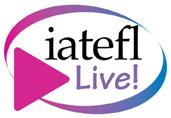
If you’ve missed any of our IATEFL Live shows, you can now watch the recorded sessions at your convenience. Check them out on YouTube or LinkedIn
IATEFL Patron
Jan Blake
IATEFL Ambassadors
Evan Frendo, Sarah Mercer, Sandy Millin, George Pickering, Syke Annamma Kumaran and Harry Kuchah Kuchah
Find out more at https://www.iatefl.org/about/whoswho-iatefl
Advisory Council
As Editor of the ELTJ: Dr Alessia Cogo
As representative of the British Council: Mike Solly
Individual members: Amos Paran and Catherine Walter
Board of Trustees
President: Aleksandra Popovski president@iatefl.org
Vice President: Christopher Graham vp@iatefl.org
Treasurer: Bethany Cagnol treasurer@iatefl.org
Secretary: Maria-Araxi Sachpazian secretary@iatefl.org
Membership Committee Chair: Gerhard Erasmus memcom@iatefl.org
Special Interest Group (SIG) Representative: Andy Hockley andy@iatefl.org
Associates Representative: Jean Theuma associaterep@iatefl.org
Digital Committee Chair: Georgia K. Papamichailidou georgia@iatefl.org
Executive Committee Members
Associates: Jean Theuma (Chair), Mirela Cristina Manea Gültekin, Freya Rutt and Ewa Minkowska (Head Office representatives)
Conference: Aleksandra Popovski (Chair), Metin Esen, Colm Downes and Sanja Bozinovic. Head Office representatives: Alex Waller, Sarah Ward, Louise Atkins, Jon Burton and Laura Creed
Digital: Georgia K. Papamichailidou (Chair), Sanja Bozinovic, Marcio Oliveira, Pola Papadopoulou and Louise Atkins (Head Office representative)
Membership: Gerhard Erasmus (Chair), Syke Annamma Kumaran, Freya Rutt and Ewa Minkowska (Head Office representatives)
Publications: Christopher Graham (Chair), Marina Gonzalez, Vicky Papageorgiou, Arum Perwitasari and Ewa Minkowska (Head Office representative)
Other committees and roles
Scholarship Committee: Christian Ludwig (Chair), Ben Beaumont, Laura Creed (Head Office representative), Blerta Mustafa, Amos Paran, and Nora Tartsay-Nemeth
Voices Editor: Derek Philip-Xu editor@iatefl.org
Conference Selections Editor: Deborah Bullock cseditor@iatefl.org
IATEFL Representative on the ELTJ Editorial panel: Shelagh Rixon
IATEFL Representative on the ELTJ Advisory Board: Richard Smith
Please visit the individual SIG website for a list of current committee members
Business English (BE) www.besig.org
Joint Coordinators: Marjorie Rosenberg & Sarah Plochl besig@iatefl.org
English for Speakers of Other Languages (ES(O)L) https://iateflesolsig.wordpress.com
Coordinator: Vivi Bairami esolsig@iatefl.org
English for Specific Purposes (ESP) https://espsig.iatefl.org
Coordinator: Caroline Hyde-Simon espsig@iatefl.org
Global Issues (GI) https://gisig.iatefl.org
Coordinator: Nick Bilbrough and Rajaa Jasser gisig@iatefl.org
Inclusive Practices & SEN (IP&SEN) https://ipsen.iatefl.org
Joint Coordinators: Aysen Deger and Giovanni Licata ipsensig@iatefl.org
Learner Autonomy (LA) https://lasig.iatefl.org
Joint Coordinators: Lawrie Moore-Walter and Giovanna Tassinari lasig@iatefl.org
Leadership and Management (LAM)
Coordinator: Barbara Craig and Josh Round lamsig@iatefl.org
Literature (Lit) https://www.iatefllitsig.org/ Coordinator: Gerhard Finster litsig@iatefl.org
Learning Technologies (LT) https://ltsig.iatefl.org Coordinator: Maria Diakou ltsig@iatefl.org
Materials Writing (MaW) https://mawsig.iatefl.org
Coordinator: Heather Buchanan mawsig@iatefl. org
Pronunciation (Pron) https://pronsig.iatefl.org
Joint Coordinators: Gemma Archer and Adam Scott pronsig@iatefl.org
Research (Res) https://resig.weebly.com Coordinator: Ernesto Vargas Gil resig@iatefl.org
Teacher Development (TD) https://tdsig.org
Coordinator: Cecilia Lemos and James Taylor tdsig@iatefl.org
Testing Evaluation and Assessment (TEA) https://tea.iatefl.org
Joint Coordinators: Maria Davou and Joanna Wrzesinska teasig@iatefl.org
Teacher Training and Education (TTEd) https://ttedsig.iatefl.org
Joint Coordinators: Bahar Gun and Clare Hayward ttedsig@iatefl.org
Young Learners and Teenagers (YLT) https://yltsig.iatefl.org
Coordinator: Laura McWilliams yltsig@iatefl.org
ACPI (Costa Rica) http://www.acpi-tesol.com
AMATE (Czech Republic) www.amate.cz
ANELTA (Angola)
ATECR (Czech Republic) http://www.atecr.weebly.com
ATEF (Finland) http://www.suomenenglanninopettajat.fi
ATEL (Lebanon) http://www.atel-lb.org
ATETE (Denmark)
AzerELTA (Iran, Islamic Republic of) http://www.eltanet.org
AzETA (Azerbaijan) http://www.azeta.az
BELTA (Bangladesh) http://www.belta-bd.org
BELTA (Belgium) http://www.beltabelgium.com
BETA (Bolivia)
BETA (Burkina Faso)
BETA Bulgaria (Bulgaria) http://www.beta-iatefl.org
BRAZTESOL (Brazil) http://www.braztesol.org.br
CAMELTA (Cameroon) http://www.cameltacameroon.weebly.com
CINELTA (Formerly CI-ATEFL) (Côte d’Ivoire) https://www.facebook.com/cinelta/about E and M - GATE (Germany) http://englisch-und-mehr.de
EELPA (Ethiopia)
ELTA (Serbia) (Serbia) http://elta.org.rs
ELTA Albania (English Language Teachers Association of Albania) (Albania)
ELTA Rhine (Germany) http://www.elta-rhine.de
ELTA/GB (Guinea-Bissau) http://eltagb1.wixsite.com/ elta-gb
ELTAF (Germany) https://eltaf.de/
ELTAM Mongolia (Mongolia) http://www. mongoliatesol.com
ELTAM Montenegro (Montenegro) https://www.eltam.me/
ELTAN (Nigeria)
ELTAS (Germany) www.eltas.de
ELTAU (Germany) http://www.eltau.de
ETAB (Bangladesh) https://www.etabbd.com/
ETAG (Georgia) www.etag.ge
ETAI (Israel) http://www.etai.org.il
ETAS (Switzerland) http://www.e-tas.ch
FAAPI (Argentina) www.faapi.org.ar
FEELTA (Russian Federation) www.feelta.wl.dvgu.ru
FORTELL (India) www.fortell.org
GEN TEFL (Thailand) www.gentefl.org
HELTA eV (Germany) www.helta.de
HUPE (Croatia) http://www.hupe.hr
IATEFL Poland (Poland) https://iatefl.org.pl/en/
IATEFL Slovenia (Slovenia) http://www.iatefl.si
IndiaCALL (India)
Chief Executive: Jon Burton
Deputy Chief Executive: Louise Atkins
Senior Bookkeeper: Iwona Minkowska
Conference Programme Coordinator: Sarah Ward
Conference Planning Officer: Laura Creed
Exhibition, Sponsorship and Advertising Officer: Alex Waller
Volunteer Support Officer: Charlotte Burton
Membership and Careers Officer: Freya Rutt
Membership and Publications Officer: Ewa Minkowska
Finance Administrator: Linda James
The IATEFL Head Office team are happy to help members or non-members with their questions and requests.
Membership enquiries: membership@iatefl.org
Finance and payment enquiries: finance@iatefl.org
Conference enquiries: conference@iatefl.org
Advertising, sponsorship and exhibition: marketing@iatefl.org
General enquiries: info@iatefl.org
Or call in office hours UK time: +44 (0)1795 591414. (as of October 2024)
INGED (Turkey) http://inged.org.tr/
JALT (Japan) http://jalt.org
KazAELT (Kazakhstan) http://kazaelt.kz
KOMELTA (Russian Federation) https://vk.com/komelta
KOTESOL (Korea, Republic of) http://www.koreatesol.org/
KSAALT TESOL (Saudi Arabia) http://www.ksaalttesol.org
LAKMA (Lithuania) http://lakmaonline.lt/ LATAZ (Zambia)
LATE (Latvia) http://www.late.lv
LEND - Lingua e nuova didattica (Italy) https://www.lend.it/
MATEFL (Malta) http://www.matefl.org
MELTA (Germany) https://melta.de/
META (Moldova) http://meta-moldova.md
MEXTESOL (Mexico) http://mextesol.org.mx
NAETSA (South Africa)
NATECLA (United Kingdom) http://www.natecla.org.uk
NATESOL (United Kingdom) http://www.natesol.org
NELTA (Nepal) http://www.nelta.org.np
NileTESOL (Egypt) http://www.niletesol.org
PAET (Cyprus)
Panama TESOL (United States) https://panamatesol.com/
Public Association of teachers of English; Belarus (Was BelNATE) (Belarus) http://belnate.www.by/
RATE (Romania) www.rate.org.ro
SATEFL (United Kingdom) http://www.satefl.co.uk
SELTA (Senegal) www.selta.sites.google.com/site/ englishlanguagecell
SLTA (Sweden) www.spraklararna.se
SPELT (Pakistan) http://www.spelt.org.pk
Sudan ELDA (Sudan) Sudan ELDA (Sudan)
TATE (Tunisia) tate.tn/
TEFL (China) http://www.telf-china.net
TEFL (Kuwait) (Kuwait) https://teflkuwait.com/
TELTA (Tanzania, United Republic of)
TESOL Canada (Canada) https://tesolcanada.org/
TESOL (France) http://www.tesol-france.org
TESOL (Greece) www.tesolgreece.org
TESOL Macedonia-Thrace N. Greece (Greece) http://www.tesolmacedoniathrace.org
TESOL (Spain) www.tesol-spain.org
TESOL (Turkey) http://www.tesolinturkey.org
UALTA (Ukraine) http://ualta.in.ua
UzTEA (Uzbekistan) http://www.uztea.uz
WITESOL (United States) http://witesol.com
YALS (Serbia) http://www.yals.rs
